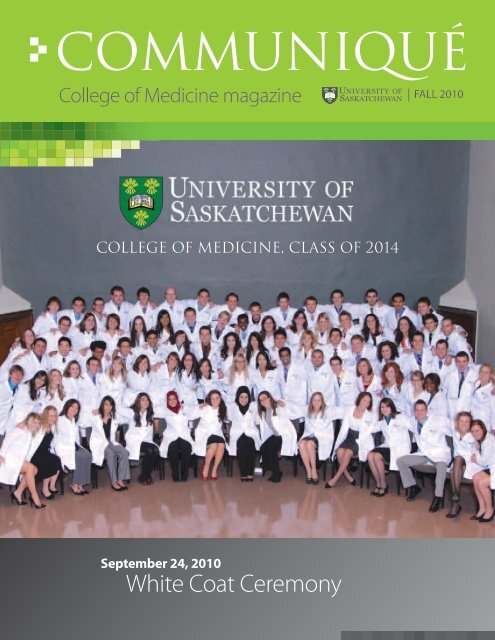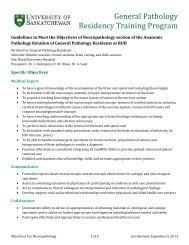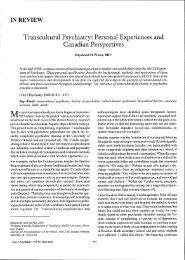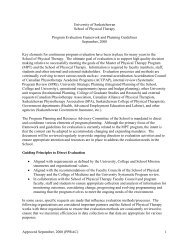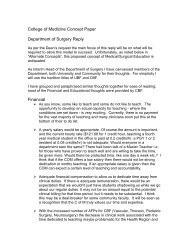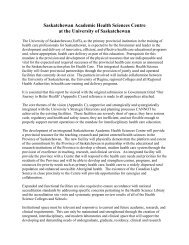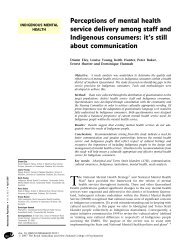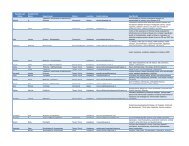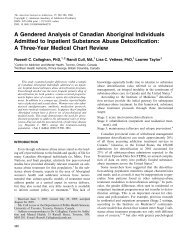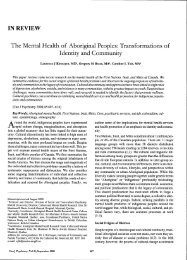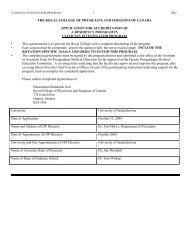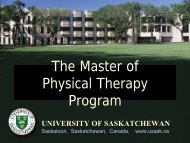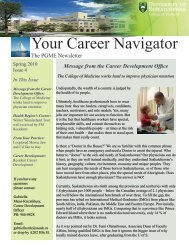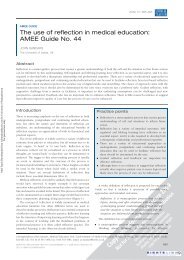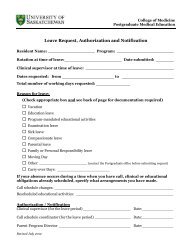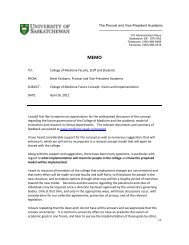COMMUNIQUé - College of Medicine - University of Saskatchewan
COMMUNIQUé - College of Medicine - University of Saskatchewan
COMMUNIQUé - College of Medicine - University of Saskatchewan
Create successful ePaper yourself
Turn your PDF publications into a flip-book with our unique Google optimized e-Paper software.
<strong>COMMUNIQUé</strong><br />
<strong>College</strong> <strong>of</strong> <strong>Medicine</strong> magazine<br />
FALL 2010<br />
<strong>College</strong> <strong>of</strong> <strong>Medicine</strong>, Class <strong>of</strong> 2014<br />
September 24, 2010<br />
White Coat Ceremony
Table <strong>of</strong> Contents<br />
Dean’s Message 1<br />
Why and How We Care<br />
Social Accountability at the <strong>College</strong> <strong>of</strong> <strong>Medicine</strong> 2<br />
The Future <strong>of</strong> Medical Education in Canada 6<br />
Research<br />
Smart cities, healthy kids 9<br />
Exploring fertility in space 10<br />
Depression, pills and Alzeimer’s disease 11<br />
Creating a Provincial Campus<br />
Distributed Medical Education moves forward 12<br />
Celebrating 25 years <strong>of</strong> Northern Medical Services 14<br />
<strong>College</strong> Awards and Honours 16<br />
SMSS Student Corner 18<br />
2010 and Beyond – News from PAIRS 20<br />
Aboriginal Programming 21<br />
Health Sciences Capital Campaign 22<br />
School <strong>of</strong> Physical Athabasca Therapy 24<br />
Leadership Team<br />
Dean <strong>of</strong> <strong>Medicine</strong>: Dr. William Albritton<br />
FALL 2010<br />
Associate Dean, Biomedical Sciences and Graduate Studies:<br />
Dr. Nick Ovsenek<br />
Associate Dean, Faculty Affairs: Dr. Olufemi Olatunbosun<br />
Associate Dean, Medical Education: Dr. Shelia Harding (on leave)<br />
Associate Dean, Physical Therapy and Rehabilitation Sciences:<br />
Dr. Liz Harrison<br />
Associate Dean, Regina Programs: Dr. Gill White<br />
Associate Dean, Research: Dr. Lou Qualtiere<br />
Associate Dean, Rural and Northern Medical Programs:<br />
Dr. Tom Smith-Windsor<br />
Associate Dean, Saskatoon Programs: Dr. Grant Stoneham<br />
Assistant Dean, Continuing Pr<strong>of</strong>essional Learning: Dr. Penny Davis<br />
Assistant Dean, Postgraduate Medical Education: Dr. Anurag Saxena<br />
Assistant Dean, Undergraduate Medical Education: Dr. Gary Linassi<br />
Director, Admissions: Dr. Barry Ziola<br />
Director, Educational Support and Development: Dr. Marcel D’Eon<br />
Director, Student Affairs: Dr. Susan Gilmer (acting)<br />
Keewatin Yatthé<br />
s Research<br />
Marnawetan<br />
Churchill<br />
River<br />
Smart cities, healthy kids<br />
Prairie<br />
North<br />
Saskatoon<br />
Heartland 12<br />
Sunrise<br />
s Distributed Medical Education<br />
Creating a Provincial Regina Campus<br />
Cypress<br />
Prince<br />
Albert<br />
Parkland<br />
Five Hills<br />
21<br />
Kelsey Trail<br />
Qu’appelle<br />
Sun Country<br />
s Aboriginal Programming<br />
Aboriginal coordinator<br />
joins the <strong>College</strong> <strong>of</strong> <strong>Medicine</strong><br />
14<br />
22<br />
s<br />
s<br />
Northern<br />
Medical Services<br />
Celebrating<br />
25 years<br />
Health Sciences<br />
9<br />
Capital Campaign<br />
Building the<br />
foundation<br />
for health<br />
sciences<br />
education<br />
and research<br />
Chief Financial Officer and Director <strong>of</strong> Administration: Ms. Ann Schultz<br />
Manager, Human Resources: Ms. Tracey Wray<br />
Department Heads<br />
Anatomy and Cell Biology: Dr. Pat Krone (acting)<br />
Anesthesia, Perioperative <strong>Medicine</strong> and Pain Management:<br />
Dr. David Campbell<br />
Biochemistry: Dr. Ramji Khandelwal<br />
Community Health and Epidemiology: Dr. Nazeem Muhajarine<br />
Family <strong>Medicine</strong>: Dr. Alanna Danilkewich (acting)<br />
Medical Imaging: Dr. Sheldon Wiebe<br />
<strong>Medicine</strong>: Dr. Vernon Hoeppner<br />
Microbiology and Immunology: Dr. Peter Bretscher<br />
Obstetrics, Gynecology and Reproductive Sciences:<br />
Dr. Tom Mainprize<br />
Pathology and Laboratory <strong>Medicine</strong>: Dr. John Krahn<br />
Pediatrics: Dr. Bill Bingham<br />
Pharmacology: Dr. Venkat Gopalakrishnan<br />
Physical <strong>Medicine</strong> and Rehabilitation: Dr. Lila Rudachyk<br />
Physiology: Dr. Michel Desautels<br />
Psychiatry: Dr. Marilyn Baetz<br />
School <strong>of</strong> Physical Therapy: Dr. Angela Busch<br />
Surgery: Dr. Bill Dust (acting)<br />
Advancement Team<br />
Alumni Relations: Ms. Verity Moore-Wright<br />
Communications: Ms. Laura Herman<br />
Development: Mr. Fred J. Matiko<br />
Support: Ms. Christine Wood<br />
Design: Deanna Miller<br />
<strong>COMMUNIQUé</strong> <strong>College</strong> <strong>of</strong> <strong>Medicine</strong> magazine<br />
Published by the <strong>College</strong> <strong>of</strong> <strong>Medicine</strong>, <strong>University</strong> <strong>of</strong> <strong>Saskatchewan</strong>.<br />
For regular updates, please visit www. medicine.usask.ca<br />
C O M M U N I Q U É<br />
<strong>College</strong> <strong>of</strong> <strong>Medicine</strong> • <strong>University</strong> <strong>of</strong> <strong>Saskatchewan</strong>
One <strong>of</strong> the ways the <strong>College</strong> will be able to achieve<br />
increased enrolment will be through continued<br />
“expansion <strong>of</strong> distributed medical education<br />
”<br />
Dean’s<br />
Message<br />
Colleagues, Alumni, Friends,<br />
It was only a few short weeks ago we had the pleasure <strong>of</strong> welcoming<br />
our newest undergraduate students, the Class <strong>of</strong> 2014, to the medical<br />
pr<strong>of</strong>ession at our White Coat Ceremony. It was the perfect opportunity<br />
to look forward with optimism at the budding careers <strong>of</strong> these eager<br />
students. Proud family members and friends watched as eighty-four<br />
students received their first white coat from respected members <strong>of</strong> our<br />
physician community. These ceremonies are a relatively new tradition in<br />
Canadian schools and introduced here by Dr. Sheila Harding, Associate<br />
Dean – Medical Education. They serve as an important milestone in<br />
a learner’s academic and service life. The white coat has long been a<br />
symbol <strong>of</strong> our pr<strong>of</strong>ession, but for these newest members the white<br />
coat is meant to serve as a symbolic representation <strong>of</strong> their personal<br />
commitment to life-long learning and service to their patients and<br />
the pr<strong>of</strong>ession.<br />
Later that same evening we played host to the <strong>College</strong> <strong>of</strong> <strong>Medicine</strong>’s<br />
first Annual Homecoming BBQ. For anyone who joined us at the event,<br />
I hope you’ll agree the southern food and bluegrass band made for an<br />
enjoyable evening and the weather was beautiful. Be sure to reserve<br />
your tickets early for next year’s Homecoming and let us know how we<br />
can make it even more enjoyable. Aside from ceremonies and BBQ’s,<br />
the hard work <strong>of</strong> running our <strong>College</strong> <strong>of</strong> <strong>Medicine</strong> has continued and<br />
we have many successes to share with you.<br />
I think <strong>of</strong> the eight-year renewal <strong>of</strong> our undergraduate medical<br />
education program. In its report, the Committee on the Accreditation<br />
<strong>of</strong> Canadian Medical Schools (CACMS) and its American counterpart,<br />
the Liaison Committee on Medical Education (LCME), cited the <strong>College</strong><br />
<strong>of</strong> <strong>Medicine</strong>’s integrated planning processes, strong partnerships in<br />
recruitment, education and community engagement, its leadership<br />
in social accountability, and its “exceptionally supportive” services for<br />
students and residents in Regina among our strengths. We are currently<br />
preparing for a secretariat fact-finding visit in March 2011 where the<br />
adjudicators will look at our progress on the Academic Health Sciences<br />
project, faculty expansion and finances in preparation for an expanded<br />
class size <strong>of</strong> 100 students.<br />
One <strong>of</strong> the ways the <strong>College</strong> will be able to achieve increased enrolment<br />
will be through continued expansion <strong>of</strong> distributed medical education,<br />
both for our undergraduate students and residents. We’ve made several<br />
strides in this regard. In July, we celebrated the expansion <strong>of</strong> our Family<br />
<strong>Medicine</strong> Residency program to Swift Current, where four clinical<br />
residents will receive their training. In August, twelve <strong>of</strong> our third-year<br />
undergraduate students began their full-time studies based in Regina.<br />
Through video-conferencing and interactive teaching technologies,<br />
the Regina site is linked to Saskatoon and we now have the ability to<br />
<strong>of</strong>fer lectures from either location. We are planning to also increase our<br />
programs in Prince Albert and to add new sites to our programs.<br />
We are also working to implement the ten recommendations and five<br />
enabling recommendations brought forward in the Association <strong>of</strong><br />
Faculties <strong>of</strong> <strong>Medicine</strong> <strong>of</strong> Canada (AFMC) Report entitled The Future <strong>of</strong><br />
Medical Education in Canada (FMEC): A Collective Vision for MD Education.<br />
This initiative and our work in this regard, is further described on<br />
page 6. In addition to helping to continue to focus our work in social<br />
accountability, it also will help us to further develop our biomedical<br />
science programs that have been so successful at the undergraduate<br />
BSc and graduate studies (MSc and PhD) level. The work that the<br />
biomedical science departments have done in the past several years<br />
developing a core platform for studies in Biochemistry, Physiology,<br />
Pharmacology, Microbiology and Immunology, and Anatomy and Cell<br />
Biology under the leadership <strong>of</strong> Dr. Nick Ovsenek has been remarkable.<br />
To complement our work in education, we have begun turning our<br />
time and attention to writing our <strong>College</strong>’s next integrated plan, the<br />
third such plan we have developed as part <strong>of</strong> the <strong>University</strong>’s fouryear<br />
planning cycle. Dr. Sheila Harding will be leading the <strong>College</strong> <strong>of</strong><br />
<strong>Medicine</strong> team in determining our priorities for 2012–2016. This type<br />
<strong>of</strong> planning exercise enables us to align our academic priorities with<br />
financial resources and helps to ensure our work at the <strong>College</strong> level<br />
is consistent with the overall strategic directions <strong>of</strong> the <strong>University</strong>. As<br />
we move further along in this process, information will be posted on<br />
our web site at www.medicine.usask.ca/leadership/integrated-plan<br />
and I encourage you, especially those <strong>of</strong> you who are members<br />
<strong>of</strong> faculty, to engage in what is meant to be a collaborative and<br />
empowering process.<br />
Finally, as you may know, I am in the penultimate year <strong>of</strong> my deanship<br />
and will not be seeking a renewal <strong>of</strong> my appointment. As such, the<br />
<strong>University</strong> is embarking on a search process for my successor. This<br />
position comes with many difficult trials and challenges, but is also<br />
hugely satisfying and rewarding. I am confident the <strong>University</strong> will find<br />
a capable leader for the <strong>College</strong> to implement the third Integrated Plan.<br />
I hope you will enjoy this latest edition <strong>of</strong> Communiqué. Please let us<br />
know what you think and how we can keep you better informed <strong>of</strong> the<br />
work <strong>of</strong> the <strong>College</strong>.<br />
Sincerely,<br />
William Albritton<br />
Dean, <strong>College</strong> <strong>of</strong> <strong>Medicine</strong><br />
<strong>University</strong> <strong>of</strong> <strong>Saskatchewan</strong><br />
<strong>University</strong> <strong>of</strong> <strong>Saskatchewan</strong> • <strong>College</strong> <strong>of</strong> <strong>Medicine</strong> C O M M U N I Q U É 1
Why and how<br />
we CAre<br />
In 1995, the World Health Organization<br />
formally defined social accountability as<br />
it relates to medical schools, outlining<br />
the obligation <strong>of</strong> educational institutions<br />
to be accountable to the health needs <strong>of</strong><br />
the communities they serve. These needs<br />
are to be collaboratively identified and<br />
responded to by governments, healthcare<br />
organizations, academic institutions and<br />
the communities involved.<br />
In 2001 Health Canada and the Association<br />
<strong>of</strong> Faculties <strong>of</strong> <strong>Medicine</strong> <strong>of</strong> Canada (AFMC)<br />
published Social Accountability: A Vision<br />
for Canadian Medical Schools which<br />
states that the “primary goal <strong>of</strong> medical<br />
education is to prepare graduates to<br />
practice effectively in reducing the burden<br />
<strong>of</strong> illness and improving the health <strong>of</strong> their<br />
communities”. This 2001 report examined<br />
Canadian medical education and furthered<br />
the notion <strong>of</strong> social accountability through<br />
specific recommendations which include:<br />
• addressing the needs <strong>of</strong> diverse<br />
individuals and communities in Canada<br />
and around the world<br />
• integrating concepts <strong>of</strong> prevention and<br />
the social determinants <strong>of</strong> health in<br />
medical curricula, and<br />
• providing students with first-hand<br />
experience in community settings and<br />
among distinct populations to broaden<br />
the learning context<br />
In response, our <strong>College</strong> <strong>of</strong> <strong>Medicine</strong><br />
created a Social Accountability<br />
Committee in 2004. The Committee is<br />
tasked with overseeing the integration<br />
and implementation <strong>of</strong> these principles<br />
into all education, research, and service<br />
activities <strong>of</strong> the <strong>College</strong> and ensuring<br />
on-going sustainability <strong>of</strong> these initiatives.<br />
Strategic planning was undertaken<br />
by the committee to set goals for the<br />
further development <strong>of</strong> a culture <strong>of</strong><br />
social accountability in the <strong>College</strong> <strong>of</strong><br />
<strong>Medicine</strong> and these ideas were referenced<br />
prominently throughout the <strong>College</strong> <strong>of</strong><br />
<strong>Medicine</strong>’s Integrated<br />
Plan for 2008–2012.<br />
Today, the Social Accountability Committee<br />
is composed <strong>of</strong> faculty representing a<br />
cross-section <strong>of</strong> departments, members<br />
<strong>of</strong> the educational administration,<br />
students, community representatives and<br />
practicing physicians. It is chaired by a<br />
quarter time faculty position, supported<br />
by a full-time coordinator and has been<br />
formalized as a Standing Committee<br />
<strong>of</strong> Faculty Council. These steps have<br />
accorded the committee further legitimacy,<br />
changing it from an “at-pleasure” satellite<br />
<strong>of</strong> the current administration to a more<br />
permanent status within the institution.<br />
Discussions are currently underway<br />
regarding the establishment <strong>of</strong> a Division<br />
<strong>of</strong> Social Accountability, to be hosted by a<br />
department within the <strong>College</strong> <strong>of</strong> <strong>Medicine</strong>.<br />
s<br />
2 C O M M U N I Q U É <strong>College</strong> <strong>of</strong> <strong>Medicine</strong> • <strong>University</strong> <strong>of</strong> <strong>Saskatchewan</strong>
social ACCOUNtability<br />
The Social Accountability committee<br />
has met with departments throughout<br />
the <strong>College</strong> <strong>of</strong> <strong>Medicine</strong> to gain an<br />
understanding <strong>of</strong> existing activities that<br />
could be described as socially accountable.<br />
Reflection on these discussions led the<br />
committee to describe four key areas<br />
<strong>of</strong> activity within a medical school:<br />
summarized by the acronym CARE.<br />
• Clinical activity: addressing priority<br />
problems, being responsive to changing<br />
community needs, including overcoming<br />
barriers to access<br />
• Advocacy: speaking out on behalf <strong>of</strong><br />
underserved populations or neglected<br />
conditions and working with partners<br />
and policy-makers to translate a vision <strong>of</strong><br />
a socially accountable patient-centered<br />
health care system<br />
• Research: conducting curiosity-based<br />
research that is responsive to perceived<br />
needs and translated into evidencebased<br />
practice and quality care<br />
• Education and training: on-going<br />
modeling and teaching pr<strong>of</strong>essionalism<br />
and community-responsiveness,<br />
providing opportunities for servicelearning<br />
and seeking to incorporate<br />
social accountability into practical<br />
training and continuing education<br />
throughout practice life<br />
Beyond clever wordplay, the CARE model<br />
is a useful tool, helping to guide social<br />
accountability initiatives towards the<br />
priority health concerns <strong>of</strong> local, regional,<br />
national and international communities<br />
while working towards a health system<br />
that is more responsive and socially<br />
accountable.<br />
Student initiative has driven the<br />
development <strong>of</strong> numerous social<br />
accountability subcommittees in our<br />
<strong>College</strong>. These subcommittees work<br />
to address key issues relevant to the<br />
communities served by the <strong>College</strong> <strong>of</strong><br />
<strong>Medicine</strong> and have had far-reaching<br />
impacts on the <strong>College</strong> and the local<br />
and global community, from changes in<br />
curricula and admissions to community<br />
programming and international<br />
educational experiences. Some <strong>of</strong><br />
the current groups include:<br />
Aboriginal Health Committee: recognizes<br />
the significant health disparities faced<br />
by the First Nations and Métis people <strong>of</strong><br />
<strong>Saskatchewan</strong>, and attempts to better<br />
coordinate ongoing activities in the <strong>College</strong><br />
<strong>of</strong> <strong>Medicine</strong><br />
Aboriginal, Rural and Remote Health<br />
Group: hosts speakers and carries out<br />
community tours to deepen student<br />
understanding <strong>of</strong> health in Aboriginal and<br />
rural communities<br />
s<br />
<strong>University</strong> <strong>of</strong> <strong>Saskatchewan</strong> • <strong>College</strong> <strong>of</strong> <strong>Medicine</strong> C O M M U N I Q U É 3
Why and how we CARE continued<br />
Community Health for Community<br />
Change: focuses on promoting the<br />
principles <strong>of</strong> community health and<br />
bridging the <strong>University</strong> and community<br />
Equity, Gender and Diversity Committee:<br />
works to advocate, support and promote<br />
equity and diversity within the <strong>College</strong> <strong>of</strong><br />
<strong>Medicine</strong>, supports and encourages student<br />
and faculty awareness <strong>of</strong> equity, diversity<br />
and gender in their education, research<br />
and service undertakings, and is a resource<br />
to assist in dealing with questions and<br />
concerns <strong>of</strong> faculty, students and staff at<br />
the <strong>College</strong> <strong>of</strong> <strong>Medicine</strong><br />
Geriatric Interest Group: focuses on the<br />
under-addressed issues in care <strong>of</strong> the elderly<br />
Global Health Committee: oversees the<br />
<strong>College</strong>’s global health initiatives, and<br />
promotes faculty and student engagement<br />
in health initiatives around the globe that<br />
support social accountability<br />
Health Science Camps for Kids: teaches<br />
junior high students in urban and remote<br />
communities about careers in the health<br />
sciences<br />
Immigrant and Refugee Health<br />
Committee: seeks to understand and<br />
address unmet health needs <strong>of</strong> the<br />
growing immigrant and refugee population<br />
in Saskatoon and <strong>Saskatchewan</strong><br />
Political Action Committee: trains<br />
students in lobbying government for<br />
health advocacy<br />
Reproductive Action Group: educates<br />
students and communities on sexual health<br />
These groups apply the CARE model<br />
to assess how their work addresses<br />
each <strong>of</strong> the four elements. A scan <strong>of</strong><br />
the work related to the area <strong>of</strong> interest<br />
<strong>of</strong> a given subcommittee is carried out<br />
to understand existing content, be it<br />
curricular or extra-curricular. Projects are<br />
then designed to address identified gaps.<br />
These projects might include new course<br />
content, an independent speaker series,<br />
a service-learning program for students,<br />
sending faculty and students to relevant<br />
conferences, or initiating collaborative work<br />
to introduce a new clinical service. These<br />
activities are then reported back to the<br />
larger Social Accountability Committee,<br />
where the CARE model is again applied to<br />
evaluate the success <strong>of</strong> the overall initiative<br />
and guide future activities.<br />
In addition to the subcommittees,<br />
social accountability in the <strong>College</strong> <strong>of</strong><br />
<strong>Medicine</strong> operates through a number<br />
<strong>of</strong> unique projects.<br />
Student Wellness Initiative Toward<br />
Community Health (SWITCH) is a<br />
student-run interdisciplinary clinic serving<br />
Saskatoon’s inner-city neighborhoods.<br />
s<br />
4 C O M M U N I Q U É <strong>College</strong> <strong>of</strong> <strong>Medicine</strong> • <strong>University</strong> <strong>of</strong> <strong>Saskatchewan</strong>
Over 50% <strong>of</strong> medical students spend time<br />
volunteering at SWITCH.<br />
Making the Links is a multi-site<br />
longitudinal service-learning experience.<br />
Selected medical students participating<br />
in the program spend the summer after<br />
their first year in either the Northern<br />
Métis community <strong>of</strong> Ile a-la-Crosse or on a<br />
reserve nearby Buffalo River Dene Nation.<br />
Students then work at SWITCH during the<br />
school year, and spend six weeks <strong>of</strong> the<br />
following summer in rural Mozambique.<br />
Between these three experiences students<br />
participate in all aspects <strong>of</strong> the CARE<br />
model, and develop an understanding<br />
<strong>of</strong> the commonalities and differences in<br />
three diverse low-resource settings:<br />
rural, remote Aboriginal communities,<br />
an inner-city urban population and rural<br />
Sub-Saharan Africa.<br />
Student Energy in Action for Regina<br />
Community Health (SEARCH) <strong>of</strong>fers<br />
a SWITCH-like interdisciplinary clinic<br />
approach in <strong>Saskatchewan</strong>’s capitol city.<br />
All three projects have arisen as a direct<br />
result <strong>of</strong> student initiatives. Students have<br />
long clamored for more service-learning<br />
experiences, for meaningful interaction and<br />
education regarding health issues <strong>of</strong> the<br />
underserved. Above all, through in-depth<br />
service-learning activity, students gain<br />
experiential understanding <strong>of</strong> the crucial<br />
importance <strong>of</strong> the social determinants<br />
<strong>of</strong> health. These experiences provide the<br />
powerful opportunity for mutual change…<br />
in the learner, his or her teachers and<br />
the community themselves, bringing to<br />
life the fundamental elements <strong>of</strong> social<br />
accountability.<br />
The plethora <strong>of</strong> initiatives demonstrates<br />
the diversity <strong>of</strong> areas, interests and multidisciplinary<br />
collaboration that social<br />
accountability encompasses. The recent<br />
expansion <strong>of</strong> these groups reflects a culture<br />
<strong>of</strong> “civic pr<strong>of</strong>essionalism” among medical<br />
students, where their scope <strong>of</strong> medicine<br />
has broadened beyond the individual<br />
obligation to the patient to the collective<br />
obligation to local and global communities.<br />
Students informally interviewed about the<br />
proliferation <strong>of</strong> student activity suggest<br />
that changes in admissions processes and<br />
grading that emphasize life experience<br />
and communication skills have changed<br />
the makeup <strong>of</strong> the student body. They<br />
also referred to a sense that advocating for<br />
social accountability is not only acceptable<br />
at the <strong>College</strong> but expected. The level<br />
<strong>of</strong> energy, enthusiasm and passion in<br />
undertaking these initiatives embodies the<br />
need to “remind ourselves that medical<br />
education is fun - and we should avoid<br />
taking ourselves overly seriously if we want<br />
to effect practical change.” n<br />
“<br />
Reflecting on my<br />
educational experience at<br />
the <strong>College</strong> <strong>of</strong> <strong>Medicine</strong>,<br />
Making the Links was by<br />
far the most influential,<br />
challenging and<br />
rewarding experience<br />
<strong>of</strong> medical school. The<br />
importance <strong>of</strong> serving the<br />
underserved, community<br />
engagement and<br />
development, and servicelearning,<br />
reinforced by<br />
the Mtl program, guided<br />
me into a rural family<br />
medicine residency<br />
and on to a practice in<br />
Northern <strong>Saskatchewan</strong><br />
with a continued interest<br />
in Global Health. It is<br />
important to me to stay<br />
interested, engaged and<br />
excited in this career<br />
and I am so grateful to<br />
have observed successful<br />
teachers, with such strong<br />
community ties, who<br />
exemplify the rewards<br />
<strong>of</strong> social accountability<br />
in practice.<br />
”<br />
– former Making the Links<br />
participant Dr. Breanna<br />
Davis, MD, CCFP, July, 2010<br />
<strong>University</strong> <strong>of</strong> <strong>Saskatchewan</strong> • <strong>College</strong> <strong>of</strong> <strong>Medicine</strong> C O M M U N I Q U É 5
The Future<br />
<strong>of</strong> Medical Education in Canada<br />
The U <strong>of</strong> S <strong>College</strong> <strong>of</strong> <strong>Medicine</strong> ushered in a new era <strong>of</strong><br />
undergraduate medical education on January 28th, 2010 during<br />
the national launch <strong>of</strong> the report: The Future <strong>of</strong> Medical Education<br />
in Canada (FMEC): A Collective Vision for MD Education. The<br />
Association <strong>of</strong> Faculties <strong>of</strong> <strong>Medicine</strong> <strong>of</strong> Canada (AFMC) report is<br />
the first comprehensive study <strong>of</strong> medical doctor (MD) education in<br />
North America since the Flexner Report was issued 100 years ago.<br />
The 30 month FMEC project spear-headed by AFMC examined<br />
how the education programs leading to the medical doctor<br />
degree in Canada can best respond to society’s evolving needs<br />
and is rooted in the AFMC’s articulated social accountability<br />
mission for medical schools. The social accountability piece<br />
is especially relevant for our <strong>College</strong> <strong>of</strong> <strong>Medicine</strong>, as we are<br />
emerging as a national leader on this front. In fact, Dr. Ryan Meili,<br />
Chair <strong>of</strong> the <strong>College</strong>’s Social Accountability Committee, will give<br />
a presentation on the C.A.R.E. model employed by our <strong>College</strong><br />
during a plenary session at the annual AFMC Conference next<br />
May. The session is intended to provide other faculties with<br />
an overview <strong>of</strong> how our <strong>College</strong> <strong>of</strong> <strong>Medicine</strong> has incorporated<br />
social accountability programming into various aspects <strong>of</strong> our<br />
curriculum and the successes we have achieved in doing so.<br />
Changing medical education to optimize healthcare delivery and<br />
improve health status for all Canadians is the stated goal <strong>of</strong> the FMEC<br />
project. As such, the report contains ten recommendations and five<br />
enabling recommendation for medical schools. Each <strong>of</strong> the 17 Canadian<br />
Faculties <strong>of</strong> <strong>Medicine</strong> will embrace the recommendations in this report<br />
in its own unique way. Our <strong>College</strong>’s Dean, Dr. Albritton, envisions<br />
the recommendations enhancing work that is currently underway,<br />
specifically focusing on addressing individual and community needs,<br />
diversifying learning<br />
contexts, valuing<br />
generalism, and<br />
advancing inter- and<br />
intra- pr<strong>of</strong>essional<br />
practice.<br />
“For us, these<br />
recommendations<br />
strengthen the<br />
vision we have<br />
for serving<br />
the people <strong>of</strong><br />
<strong>Saskatchewan</strong>.<br />
s<br />
Recommendations and Leadership<br />
1. Address Individual and<br />
Community Needs<br />
– Dr. Tom Smith-Windsor<br />
Social responsibility and accountability<br />
are core values underpinning the roles<br />
<strong>of</strong> Canadian physicians and Faculties<br />
<strong>of</strong> <strong>Medicine</strong>. This commitment<br />
means that both individually and<br />
collectively, physicians and faculties<br />
must work to respond to the diverse<br />
needs <strong>of</strong> individuals and communities<br />
throughout Canada, as well as meeting<br />
international responsibilities to the<br />
global community.<br />
2. Enhance Admissions Processes<br />
– Dr. Barry Ziola<br />
Given the broad range <strong>of</strong> attitudes,<br />
values, and skills required <strong>of</strong><br />
physicians, Faculties <strong>of</strong> <strong>Medicine</strong><br />
must enhance admissions processes<br />
to include assessment <strong>of</strong> key values<br />
and personal characteristics <strong>of</strong> future<br />
physicians such as communication,<br />
interpersonal and collaborative skills,<br />
a range <strong>of</strong> pr<strong>of</strong>essional interests, as<br />
well as cognitive ability. Additionally, in<br />
order to achieve the desired diversity<br />
in our physician workforce, Faculties<br />
<strong>of</strong> <strong>Medicine</strong> must recruit, select,<br />
and support a representative mix <strong>of</strong><br />
medical students.<br />
3. Build on the Scientific Basis <strong>of</strong><br />
<strong>Medicine</strong> – Dr. Nick Ovsenek<br />
Given that medicine is rooted in<br />
fundamental scientific principles, both<br />
human and biological sciences must<br />
be learned in relevant and immediate<br />
clinical contexts throughout the MD<br />
Education experience. In addition, as<br />
scientific inquiry provides the basis<br />
for advancing healthcare, research<br />
interests and skills must be developed<br />
to foster a new generation <strong>of</strong> health<br />
researchers.<br />
4. Promote Prevention & Public<br />
Health – Dr. Nazeem Muhajarine<br />
Promoting a healthy Canadian<br />
population requires a multifaceted<br />
approach engaging the full continuum<br />
<strong>of</strong> health and healthcare. Faculties <strong>of</strong><br />
<strong>Medicine</strong> have a critical role to play in<br />
enabling this requirement and must<br />
therefore enhance the integration<br />
<strong>of</strong> prevention and public health<br />
competencies to a greater extent in<br />
the MD Education curriculum.<br />
5. Address the Hidden Curriculum<br />
– Dr. Penny Davis<br />
The hidden curriculum is a “set <strong>of</strong><br />
influences that function at the level <strong>of</strong><br />
organizational structure and culture,”<br />
affecting the nature <strong>of</strong> learning,<br />
pr<strong>of</strong>essional interactions, and clinical<br />
practice. Faculties <strong>of</strong> <strong>Medicine</strong> must<br />
therefore ensure that the hidden<br />
curriculum is regularly identified<br />
s<br />
6 C O M M U N I Q U É <strong>College</strong> <strong>of</strong> <strong>Medicine</strong> • <strong>University</strong> <strong>of</strong> <strong>Saskatchewan</strong>
The Patient First Review conducted by Tony Dagnone clearly<br />
outlined the need for health care providers to more fully address<br />
individual and community needs. We know <strong>Saskatchewan</strong> must<br />
also increase its number <strong>of</strong> primary care physicians and recruit and<br />
retain these skilled pr<strong>of</strong>essionals in communities throughout the<br />
province. Additionally, the recommendation to diversify learning<br />
contexts for students meshes perfectly with the <strong>College</strong>’s vision for<br />
a distributed model <strong>of</strong> medical education where learners are placed<br />
in communities throughout <strong>Saskatchewan</strong> as an integral part <strong>of</strong><br />
their training. Finally, the Health Sciences complex currently being<br />
constructed on the U <strong>of</strong> S campus will be a flagship environment<br />
for inter- and intra- pr<strong>of</strong>essional medical training.”<br />
will require a significant amount <strong>of</strong> focus and dedication. To that<br />
end, the <strong>College</strong> has formed an FMEC implementation committee,<br />
chaired by Dr. Albritton. Each <strong>of</strong> the recommendations will be<br />
championed by a member <strong>of</strong> faculty, together with a team <strong>of</strong><br />
collaborators who will determine how the <strong>College</strong> should best<br />
carry-out the report’s objectives.<br />
The FMEC committee’s goal is to have a complete implementation<br />
strategy ready to be rolled-out by the end <strong>of</strong> the 2010 – 2011<br />
academic year.<br />
s<br />
Improving Canadian MD education programs by implementing<br />
these recommendations will not only enhance the quality <strong>of</strong><br />
education in Canadian medical schools but also better equip<br />
Canada’s physicians and health care systems to respond and adapt<br />
to the changing health and societal needs that define this nation.<br />
The FMEC Collective vision is both a prescription and a platform<br />
for change.<br />
To move forward and actually implement the ten recommendations<br />
and five enabling recommendation contained in the FMEC report<br />
and addressed by students, educators<br />
and faculty throughout all stages<br />
<strong>of</strong> learning.<br />
6. Diversify Learning Context<br />
– Dr. William Albritton<br />
Canadian physicians practise in a wide<br />
range <strong>of</strong> institutional and community<br />
settings while providing the continuum<br />
<strong>of</strong> medical care. In order to prepare<br />
physicians for these realities, Faculties<br />
<strong>of</strong> <strong>Medicine</strong> must provide learning<br />
experiences throughout MD Education<br />
for all students in a variety <strong>of</strong> settings<br />
ranging from small rural communities<br />
to complex tertiary health care centres.<br />
7. Valuing Generalism<br />
– Dr. Gill White<br />
Recognizing that generalism is<br />
foundational for all physicians, MD<br />
Education must be focused on broadly<br />
based generalist content, including<br />
comprehensive family medicine.<br />
Moreover, family physicians and<br />
other generalists must be integral<br />
participants in all stages <strong>of</strong> MD<br />
Education.<br />
8. Advance Inter- and Intra-<br />
Pr<strong>of</strong>essional Practice<br />
– Dr. Liz Harrison<br />
To improve collaborative, patientcentred<br />
care, MD Education must<br />
reflect ongoing changes in scopes<br />
<strong>of</strong> practice and healthcare delivery.<br />
Faculties <strong>of</strong> <strong>Medicine</strong> must equip<br />
MD Education learners with the<br />
competencies that will enable them<br />
to function effectively as part <strong>of</strong> interand<br />
intra-pr<strong>of</strong>essional teams.<br />
9. Adopt a Competency-Based and<br />
Flexible Approach – Dr. Gary Linassi<br />
To prepare for lifelong learningputting<br />
the continuum <strong>of</strong> medical<br />
education into practice – MD<br />
Education must be based primarily on<br />
the development <strong>of</strong> core foundational<br />
competencies and complementary<br />
broad experiential learning. In<br />
addition to pre-defined curriculum<br />
requirements, MD Education must<br />
also provide flexible opportunities for<br />
students to pursue individual scholarly<br />
interests in medicine.<br />
10. Foster Medical Leadership<br />
– Dr. Anurag Saxena<br />
Medical leadership is essential in<br />
regard to both patient care and<br />
the overall health system. Faculties<br />
<strong>of</strong> <strong>Medicine</strong> must foster medical<br />
leadership for both faculty and<br />
students, including how to manage,<br />
navigate, and help transform medical<br />
practice and the health system in<br />
collaboration with others.<br />
<strong>University</strong> <strong>of</strong> <strong>Saskatchewan</strong> • <strong>College</strong> <strong>of</strong> <strong>Medicine</strong> C O M M U N I Q U É 7
The Future <strong>of</strong> Medical Education in Canada continued<br />
Enabling Recommendations<br />
Five enabling recommendations will facilitate the<br />
implementation <strong>of</strong> the FMEC recommendations:<br />
A: Realign Accreditation Standards<br />
– Dr. Sheila Harding<br />
Recognizing that accreditation is a powerful lever,<br />
Canadian medical leaders must review and realign existing<br />
CACMS standards and develop new ones, as necessary, to<br />
respond to the recommendations in this report. This may<br />
involve the alignment <strong>of</strong> undergraduate and postgraduate<br />
accreditation standards.<br />
“<br />
these recommendations<br />
strengthen the vision we<br />
have for serving the people<br />
<strong>of</strong> <strong>Saskatchewan</strong><br />
”<br />
– Dr. Albritton<br />
B: Build Capacity for Change<br />
– Dr. Marcel D’Eon<br />
Each Faculty <strong>of</strong> <strong>Medicine</strong> should carry out a review <strong>of</strong><br />
its organizational systems, processes, and structures to<br />
determine and build capacity where required to support<br />
a constructive response to these recommendations.<br />
C: Increase National Collaboration<br />
– Dr. Sheila Harding<br />
Canadian Faculties <strong>of</strong> <strong>Medicine</strong> are continually innovating<br />
and have much to <strong>of</strong>fer each other. Increased collaboration<br />
among schools, including sharing <strong>of</strong> teaching resources,<br />
evaluation frameworks, tools for common curriculum<br />
development and innovation, as well as learning resources<br />
and information technology, is desirable.<br />
D: Improve the Use <strong>of</strong> Technology<br />
– Dr. Grant Stoneham<br />
Based on rapid and evolving technology changes in how<br />
people communicate and learn, there must be increased<br />
understanding and use <strong>of</strong> technology on the part <strong>of</strong> both<br />
faculty and learners at all MD education sites.<br />
E: Enhance Faculty Development<br />
– Dr. Femi Olatunbosun<br />
Recognizing that teaching, research and leadership are<br />
core roles for physicians, faculty development in these<br />
areas must be a high priority to enable teachers and<br />
learners to respond effectively to the recommendations<br />
in this report. n<br />
8 C O M M U N I Q U É <strong>College</strong> <strong>of</strong> <strong>Medicine</strong> • <strong>University</strong> <strong>of</strong> <strong>Saskatchewan</strong>
Smart cities,<br />
healthy kids<br />
For the first time in modern history, the<br />
life expectancy <strong>of</strong> children may well drop<br />
lower than that <strong>of</strong> their parents. The reason:<br />
lifestyles that discourage physical activity<br />
and foster obesity.<br />
“To a large extent, the way we behave<br />
is shaped by our environment,” says Dr.<br />
Nazeem Muhajarine. “We tend to develop<br />
sedentary lifestyles if we don’t have a lot <strong>of</strong><br />
opportunities for physical activity, or have<br />
competing activities that discourage us<br />
from being active.”<br />
Muhajarine, leads the Healthy Children<br />
research program within the <strong>Saskatchewan</strong><br />
Population Health and Evaluation Research<br />
Unit (SPHERU), which includes researchers<br />
from the <strong>University</strong> <strong>of</strong> <strong>Saskatchewan</strong><br />
and <strong>University</strong> <strong>of</strong> Regina. Their “Smart<br />
Cities, Healthy Kids” project is looking at<br />
the design <strong>of</strong> urban neighbourhoods in<br />
Saskatoon to identify the elements that<br />
encourage children to get up and go.<br />
These elements include things such as<br />
buildings, roadways, sidewalks, parks, and<br />
green spaces, and how they contribute<br />
to increasing children’s physical activity.<br />
By learning what is and isn’t working<br />
in Saskatoon, the team hopes to inform<br />
the design <strong>of</strong> future neighbourhoods<br />
throughout <strong>Saskatchewan</strong> and<br />
across Canada.<br />
Through their research, Muhajarine and his<br />
team also seeks to shed light on how the<br />
social contexts in which children live —<br />
their families and their neighbourhood —<br />
help or hinder them in their early years. This<br />
is the type <strong>of</strong> research that he thrives on.<br />
“We have done studies looking at various<br />
factors—from family, neighbourhoods,<br />
schools, and larger society—that impact<br />
children, beginning with even before<br />
they are born to when they begin school,”<br />
Muhajarine says. “What do we see in a<br />
community that is essential to nurturing<br />
healthy children that grow up to be welladjusted,<br />
productive citizens? How can we<br />
provide these essentials?”<br />
In addition to the “Smart Cities, Healthy<br />
Kids” project, Muhajarine and his<br />
research team are also working on many<br />
other research and knowledge transfer<br />
projects in early childhood development.<br />
“I think the funding early in my career as a student<br />
(from SHRF’s precursor) has helped me start on a healthy<br />
career path, to really make a difference and contribute<br />
to <strong>Saskatchewan</strong> and elsewhere.”<br />
—Dr. Nazeem Muhajarine<br />
research<br />
They are just about to wrap up a threeyear<br />
evaluation <strong>of</strong> the effectiveness <strong>of</strong><br />
KidsFirst, the provincial government’s<br />
early childhood development program<br />
for vulnerable families with young<br />
children delivered locally at nine sites in<br />
the province. KidsFirst uses home visiting<br />
to mentor parents and connect them to<br />
needed supports, so they can be the best<br />
parents they can be, and have the healthiest<br />
children possible. Muhajarine is looking at<br />
the impact KidsFirst has made on children<br />
and their parents’ lives in the first few years<br />
<strong>of</strong> the program.<br />
Findings from previous research projects<br />
have contributed to improved programs<br />
and services for children in several ways:<br />
Saskatoon’s school boards have initiated<br />
major literacy programs and have<br />
introduced and expanded a full-time<br />
kindergarten option, while the city’s public<br />
library has improved access to services<br />
in underprivileged areas. Last year, he<br />
received CIHR funding to launch kidSKAN,<br />
the <strong>Saskatchewan</strong> Knowledge to Action<br />
Network for early childhood development<br />
(www.kidskan.ca), a provincial community<br />
<strong>of</strong> practice to connect researchers with<br />
practitioners and policymakers across<br />
the province.<br />
Muhajarine was awarded his first research<br />
grant while he was a doctoral student, from<br />
the <strong>Saskatchewan</strong> Health Research Board<br />
(a precursor to SHRF).<br />
“I believe the early funding really<br />
contributed to my development as a<br />
researcher,” Muhajarine says. “Being funded<br />
when I was fairly new to the research<br />
community as a PhD student was certainly<br />
beneficial when I subsequently applied<br />
for national grants.”<br />
Since his early days as a student, Muhajarine<br />
has continued his success in funding<br />
through a variety <strong>of</strong> post-doctoral and<br />
establishment grants through HSURC<br />
(another precursor to SHRF), and a variety<br />
<strong>of</strong> national funding sources such as the<br />
Canadian Institutes <strong>of</strong> Health Research. He<br />
has won prestigious honours such as CIHR’s<br />
Knowledge Translation Award, and SHRF’s<br />
Achievement Award. n<br />
This story and photograph provided courtesy <strong>of</strong> SHRF.<br />
Photo courtesy Brinnameade Smith.<br />
<strong>University</strong> <strong>of</strong> <strong>Saskatchewan</strong> • <strong>College</strong> <strong>of</strong> <strong>Medicine</strong> C O M M U N I Q U É 9
Exploring fertility<br />
in space<br />
Heather Allaway<br />
Growing up on a farm in rural<br />
<strong>Saskatchewan</strong>, Heather Allaway<br />
had a somewhat unusual career<br />
aspiration — she wanted to<br />
become an astronaut.<br />
Her fascination with animals and<br />
reproduction sparked an interest<br />
in exploring human fertility,<br />
which in turn led to wondering<br />
about the effects <strong>of</strong> estrogen<br />
depletion for women travelling<br />
in space.<br />
Her curiosity about this topic and her accomplishments as a<br />
graduate student in reproductive sciences at the <strong>University</strong> <strong>of</strong><br />
<strong>Saskatchewan</strong>’s <strong>College</strong> <strong>of</strong> <strong>Medicine</strong> recently landed her a place<br />
at the International Space <strong>University</strong> in Strasbourg, France with<br />
120 space-science students from around the world.<br />
When the nine-week program ended in September, Allaway<br />
entered the final year <strong>of</strong> her master’s research which is focussed<br />
on the effects on a woman’s ovaries <strong>of</strong> stopping ovaries from<br />
making the hormone estrogen, work that could be helpful in<br />
developing a new kind <strong>of</strong> morning-after pill.<br />
Her research could also shed light on how a new wave <strong>of</strong> ovarian<br />
follicles develops, paving the way for more effective treatment<br />
for infertility.<br />
Since how the body regulates estrogen can have a huge impact<br />
on bone mass, Allaway is also interested in finding a way to ensure<br />
that women who explore space can be better protected against<br />
bone density loss.<br />
“We don’t fully understand how women’s bodies are affected in<br />
space,” she says.<br />
“My study isn’t about sex in space, but about the changes<br />
in the body that occur before, during, and after pregnancy.<br />
Reproduction in space is a piece <strong>of</strong> the puzzle that needs to be<br />
understood before the exploration <strong>of</strong> the solar system can begin.”<br />
All astronauts lose bone mass when travelling in space. But<br />
hormonal contraception creates a dangerous scenario for female<br />
astronauts, who <strong>of</strong>ten must to go on long-term hormonal birth<br />
control that stops menstrual periods and lowers estrogen levels,<br />
exacerbating significant bone loss.<br />
“When you think about extended space travel, for example to<br />
Mars, you cannot afford to lose a large amount <strong>of</strong> bone mass,” says<br />
Allaway’s supervisor Roger Pierson, <strong>College</strong> <strong>of</strong> <strong>Medicine</strong> pr<strong>of</strong>essor<br />
<strong>of</strong> reproductive sciences.<br />
Bone metabolism is closely linked to estrogen and menstruation,<br />
which is why women and men’s bone densities are different, and<br />
why women in menopause have a higher risk <strong>of</strong> osteoporosis and<br />
bone fractures.<br />
By better understanding the mechanism that shuts down ovary<br />
functioning and affects estrogen levels, Allaway could contribute<br />
to the development <strong>of</strong> better emergency contraception.<br />
s<br />
Heather Allaway<br />
collecting rock samples<br />
at the Mars Desert<br />
Research Station in Utah<br />
September, 2010<br />
10 C O M M U N I Q U É <strong>College</strong> <strong>of</strong> <strong>Medicine</strong> • <strong>University</strong> <strong>of</strong> <strong>Saskatchewan</strong>
esearch<br />
Heather was selected the Best Student Paper Award at the<br />
56th Annual Conference <strong>of</strong> the Canadian fertility and<br />
andrology Society. The paper, entitled ‘ A Single 20mg dose<br />
<strong>of</strong> Aromatase Inhibitor Does Not Affect Folliculogenesis<br />
in the Folliculr Phase <strong>of</strong> the Menstrual Cycle’, was co-authored<br />
with Donna Chizen an Gregg Adams.<br />
And by learning more about how estrogen encourages the<br />
growth <strong>of</strong> ovarian follicles where eggs are developed, she<br />
could help design more effective therapy for women who have<br />
difficulties conceiving.<br />
“It’s a simple study with pr<strong>of</strong>ound implications,” Pierson says.<br />
While in France, Allaway learned about space travel and planned<br />
her research so to be relevant to a career as an astronaut.<br />
“For the next generation <strong>of</strong> astronauts, NASA and the European<br />
Space Agency will be looking for physicians, scientists and<br />
engineers as well as pilots,” says Pierson. “This is what Heather<br />
is preparing for.”<br />
In 2008, Allaway went on a two-week mission at the International<br />
Mars Society Mars Desert Research Station in Utah where researchers<br />
work in a remote environment reminiscent <strong>of</strong> the red planet.<br />
Allaway sees a need for more information to educate and<br />
empower women around the world to take control <strong>of</strong> their bodies.<br />
She recruits her own research volunteers, educating them along<br />
the way about how reproduction works.<br />
“The best part <strong>of</strong> my work is getting to know the amazing women<br />
who volunteer,” Allaway says. “They give their time to learn more<br />
about a subject that is still a touchy topic to most people.”<br />
While Pierson anticipates outstanding PhD work from Allaway, he<br />
is just as optimistic about her career in space travel, noting that<br />
“farm kids have an incredible work ethic.”<br />
Graduate student Lisa Johnson wrote the above article while<br />
completing an internship at the U <strong>of</strong> S research communications<br />
<strong>of</strong>fice. Visit www.usask/research for more stories about<br />
student research. n<br />
This article recently appeared in the Saskatoon Star Phoneix.<br />
Depression, pills<br />
and Alzheimer’s disease<br />
Is our society’s love affair with antidepressants<br />
setting us up for an epidemic <strong>of</strong> early-onset<br />
Alzheimer’s disease?<br />
“Depression doesn’t necessarily cause more<br />
Alzheimer’s disease, but what it does is it<br />
causes Alzheimer’s disease to happen earlier,”<br />
says Dr. Darrell Mousseau. “Depression is<br />
doing something to the brain that makes<br />
it much more vulnerable to developing<br />
Alzheimer’s disease earlier on.”<br />
Mousseau, a pr<strong>of</strong>essor in the U <strong>of</strong> S <strong>College</strong><br />
<strong>of</strong> <strong>Medicine</strong>’s Department <strong>of</strong> Psychiatry,<br />
together with his team, has found that an<br />
enzyme that plays an important role in<br />
depression can severely weaken brain cells<br />
and perhaps trigger the processes that lead<br />
to Alzheimer’s disease. The team is also<br />
looking at the role <strong>of</strong> antidepressants in<br />
this process.<br />
“We have to be careful about what kind <strong>of</strong><br />
drugs we’re putting into depressed patients<br />
because that could actually be creating<br />
Alzheimer’s in some people,” he says.<br />
“Instead <strong>of</strong> developing it when they’re 70,<br />
maybe they’ll develop it when they’re 50 or 40.”<br />
Dr. Mousseau holds the <strong>Saskatchewan</strong><br />
Research Chair in Alzheimer’s Disease and<br />
Related Dementia. The chair is a partnership<br />
among SHRF, the Alzheimer Society <strong>of</strong><br />
<strong>Saskatchewan</strong>, and the <strong>University</strong> <strong>of</strong><br />
<strong>Saskatchewan</strong>.<br />
Each funding partner provides $100,000<br />
per year for five years, while the U <strong>of</strong> S<br />
provides the necessary infrastructure and<br />
support. It is the first chair under SHRF’s new<br />
<strong>Saskatchewan</strong> Research Chairs program.<br />
Over the next five years <strong>of</strong> his Chair’s term<br />
Mousseau and his team hope to come<br />
closer to discovering a way to provide<br />
earlier diagnostic measures and prevent<br />
Alzheimer’s disease in a significant portion<br />
<strong>of</strong> the population.<br />
As Canada’s population ages, finding the<br />
cause <strong>of</strong> and cure for Alzheimer’s disease is<br />
expected to become critically important.<br />
In its report The Rising Tide, the Alzheimer<br />
Society estimates that if nothing is done to<br />
stop or slow the disease, by the year 2038<br />
one person will develop Alzheimer’s disease<br />
or a related dementia every two minutes<br />
in Canada. n<br />
Dr. Darrell Mousseau and his team will use advanced<br />
research tools such as those at the Canadian Light<br />
Source at the <strong>University</strong> <strong>of</strong> <strong>Saskatchewan</strong> to study<br />
links among depression, antidepressant drugs, and<br />
Alzheimer’s disease.<br />
This story and photograph provided courtesy <strong>of</strong> SHRF.<br />
<strong>University</strong> <strong>of</strong> <strong>Saskatchewan</strong> • <strong>College</strong> <strong>of</strong> <strong>Medicine</strong> C O M M U N I Q U É 11
Creating a provincial campus<br />
Distributed Medical Education moves forward<br />
With the recent $2 million in funding provided by the Ministry<br />
<strong>of</strong> Advanced Education, Employment and Immigration and<br />
the Ministry <strong>of</strong> Health, the <strong>College</strong> <strong>of</strong> <strong>Medicine</strong> is developing a<br />
plan to expand distributed medical education throughout the<br />
province. Distributed medical education (DME) is an approach<br />
that has medical students study and train in a variety <strong>of</strong> different<br />
environments, such as smaller rural facilities, as opposed to<br />
studying only at the large tertiary institutions.<br />
Dr. Tom Smith-Windsor, Associate Dean <strong>of</strong> Rural Programs, thinks<br />
the development will allow medical students to gain a wider<br />
range <strong>of</strong> experience <strong>of</strong> medicine as a whole: “Right now we’re<br />
teaching on a somewhat narrow perspective for the disease<br />
process, and not at the beginning or the end <strong>of</strong> that process<br />
where most physicians work. DME will allow students more<br />
contact with patients throughout the disease, as well as outside<br />
the hospital setting. They’ll also learn about solving medical<br />
issues within the patient’s social and economic environment.”<br />
Other medical programs in Canada are already reaping the<br />
benefits <strong>of</strong> distributed medical programs, and DME could help<br />
solve some <strong>of</strong> <strong>Saskatchewan</strong>’s specific challenges, such as a<br />
lack <strong>of</strong> family physicians, especially in rural areas. Dr. Smith-<br />
Windsor points out that “the literature on distributed medical<br />
education overwhelmingly shows that where students get the<br />
majority <strong>of</strong> their clinical experience is where they will establish<br />
practice.” Dr. Anurag Saxena, Assistant Dean <strong>of</strong> Postgraduate<br />
Medical Education at the U <strong>of</strong> S, agrees, stating that DME<br />
“has huge potential for <strong>Saskatchewan</strong> as far as recruiting and<br />
retaining general practitioners.”<br />
As with any program development, there are implementation<br />
challenges. “The training received at these distributed sites<br />
s<br />
Keewatin Yatthé<br />
Prairie<br />
North<br />
Heartland<br />
Cypress<br />
On July 7th, 2010, U <strong>of</strong> S President MacKinnon and Dean<br />
Albritton, together with Premier Brad Wall and Minister <strong>of</strong><br />
Health Don McMorris, welcomed<br />
four new family medicine residents<br />
Athabasca<br />
Prince<br />
Albert<br />
Parkland<br />
Saskatoon<br />
Marnawetan<br />
Churchill<br />
River<br />
Kelsey Trail<br />
Regina<br />
Qu’appelle<br />
Five Hills<br />
Sunrise<br />
Sun Country<br />
to Swift Current. Over the next two<br />
years, these postgraduate medical<br />
education students will be the first<br />
to receive their training outside <strong>of</strong><br />
Saskatoon, Regina or Prince Albert.<br />
Establishing the training site in<br />
Swift Current is a significant step<br />
for the <strong>College</strong> <strong>of</strong> <strong>Medicine</strong> as<br />
we continue with the expansion<br />
<strong>of</strong> our distributed medical<br />
education model.<br />
For the <strong>College</strong> <strong>of</strong> <strong>Medicine</strong>,<br />
developing a distributed model<br />
<strong>of</strong> education is essential to<br />
meeting our social accountability<br />
mandate and addressing the<br />
reforms in medical education<br />
suggested by the recently<br />
released Future <strong>of</strong> Medical<br />
Education in Canada project<br />
developed through the<br />
Association <strong>of</strong> Faculties <strong>of</strong><br />
<strong>Medicine</strong> <strong>of</strong> Canada.<br />
Specifically, enhancing<br />
our distributed education<br />
model will enable us to<br />
concentrate on three <strong>of</strong> the<br />
ten recommendations outlined in the FMEC report:<br />
1. ADDRESS INDIVIDUAl AND COMMUNIty NEEDS: The <strong>College</strong><br />
<strong>of</strong> <strong>Medicine</strong> is mandated to serve the people <strong>of</strong> <strong>Saskatchewan</strong>.<br />
For us to achieve this mandate, we must first reach the people <strong>of</strong><br />
<strong>Saskatchewan</strong>. A distributed education model is the vehicle by<br />
which we will achieve greater connectedness to the communities<br />
we seek to serve. This includes both rural and urban populations<br />
and also encompasses meaningful engagement with underserved<br />
communities.<br />
2. Diversify lEARNING CONtexts: This is at the heart <strong>of</strong> a<br />
distributed model. Students must be exposed to a wide range <strong>of</strong><br />
learning contexts in order to become well-rounded physicians.<br />
While training in large, tertiary care facilities is an important<br />
aspect <strong>of</strong> medical school, it cannot be the only environment<br />
students are exposed to.<br />
3. ValUE GENERAlISM: Recognizing that generalism is<br />
foundational for all physicians, MD education must focus on<br />
broadly generalist content, including comprehensive family<br />
medicine. Moreover, family physicians and other generalists<br />
must be integral participants in all stages <strong>of</strong> MD education.<br />
The expansion <strong>of</strong> our rural family medicine residency program<br />
to Swift Current is a positive step towards further developing<br />
our distributed medical education model and it demonstrates<br />
our commitment to serving the people <strong>of</strong> <strong>Saskatchewan</strong>.<br />
12 C O M M U N I Q U É <strong>College</strong> <strong>of</strong> <strong>Medicine</strong> • <strong>University</strong> <strong>of</strong> <strong>Saskatchewan</strong>
must be at the same rigorous, high level as the training received<br />
on campus,” says Dr. Saxena, which accordingly requires a great<br />
deal <strong>of</strong> administrative, faculty, and IT support. Dr. Gary Linassi,<br />
Assistant Dean <strong>of</strong> Undergraduate Medical Education, agrees, and<br />
describes the ideal DME program as one in which, “the satellite<br />
centres participate in a very robust way in the delivery <strong>of</strong> medical<br />
education,” adding that he would like to see “students on the U <strong>of</strong><br />
S campus being taught by instructors on other campuses, so that<br />
the flow <strong>of</strong> information goes both ways.” If successful, he believes<br />
the U <strong>of</strong> S “will have a truly provincial campus in delivering the<br />
undergraduate mission.”<br />
Distributed medical education will also help fulfill the <strong>College</strong><br />
<strong>of</strong> <strong>Medicine</strong>’s social accountability mandate. Dr. Saxena states,<br />
“social needs should be the key driver in what we do in medicine<br />
and what we do in medical education. Since many <strong>of</strong> the needs<br />
<strong>of</strong> the <strong>Saskatchewan</strong> people are not being met by the old system,<br />
new ways <strong>of</strong> filling those needs are required, and it is <strong>of</strong> crucial<br />
importance that we pursue this with great enthusiasm.”<br />
The <strong>College</strong> <strong>of</strong> <strong>Medicine</strong> presently has undergraduate learners<br />
based in Saskatoon and Regina. Phase D undergrads, or JURSI’s<br />
(Junior Undergraduate Rotating Student Interns) have the<br />
option to select training rotations at a number <strong>of</strong> additional sites.<br />
The postgraduate training programs are based in Saskatoon<br />
with some programs <strong>of</strong>fering an option <strong>of</strong> completing the entire<br />
residency in Regina, Prince Albert and Swift Current. All programs<br />
<strong>of</strong>fer community learning experiences in different rural and urban<br />
settings. The opportunities for training in areas <strong>of</strong> community<br />
needs such as Family Practice Anesthesia and Enhanced Surgical<br />
Skills are being developed to include Prince Albert, Meadow Lake<br />
and Melfort, among others. n<br />
Third Year MEDICAl StUDENts now able to tRAIN in REGINA…<br />
August 2010 marked a new beginning for twelve Phase C (or third-year)<br />
students as they continued their medical training from the <strong>College</strong>’s<br />
newest distributed education site – the renovated auditorium in the<br />
Regina General Hospital. In the past, these students would have been<br />
based in Saskatoon. The twelve third-year students joined an existing<br />
cohort <strong>of</strong> fourth-year medical students in Regina.<br />
During an event held simultaneously in the Regina and Saskatoon<br />
classrooms, Dr. Albritton said “the <strong>College</strong> <strong>of</strong> <strong>Medicine</strong> is a provincial<br />
resource mandated to serve the people <strong>of</strong> <strong>Saskatchewan</strong>, so it is<br />
important for us to have a well-established presence throughout<br />
the province.”<br />
“The RQHR is excited to be involved in this expanded partnership<br />
with the <strong>College</strong> <strong>of</strong> <strong>Medicine</strong>,” Regina Qu’Appelle Health Region<br />
CEO Dwight Nelson said. “We appreciate that our regional and<br />
medical colleagues have set aside additional time for teaching<br />
and we hope that our efforts will encourage more <strong>Saskatchewan</strong><br />
medical graduates to make their home and build their practices<br />
in southern <strong>Saskatchewan</strong>.”<br />
FAMIly MEDICINE RURAl RotatION OptIONS<br />
Athabasca<br />
Battleford<br />
Estevan<br />
Eston<br />
Fort Qu’Appelle<br />
Gravelbourg<br />
Humboldt<br />
Ile-à-la-Crosse<br />
Kindersley<br />
La Ronge<br />
Lloydminster<br />
Meadow Lake<br />
Melfort<br />
North Battleford<br />
Radville<br />
Rosetown<br />
Rosthern<br />
Swift Current<br />
Weyburn<br />
Prince Albert (starting January 2011)<br />
<strong>University</strong> <strong>of</strong> <strong>Saskatchewan</strong> • <strong>College</strong> <strong>of</strong> <strong>Medicine</strong> C O M M U N I Q U É 13
Celebrating 25 years <strong>of</strong><br />
Northern Medical Services<br />
For the past 25 years, Northern Medical Services has been filling a<br />
void by providing family physicians and stability to the North.<br />
Outgoing director Dr. Peter Butt says it’s sometimes difficult to<br />
provide that stability.<br />
“It’s an ongoing struggle in the health human resource field.<br />
We’ve got a lack <strong>of</strong> family physicians in the country, so we’re<br />
competing not only within the province but also nationally and<br />
internationally.” Right now NMS is<br />
very dependent on South African<br />
doctors.<br />
NMS has come a long way from<br />
when it first began in 1985 with six<br />
family physicians and three support<br />
staff. Now there are 31 physicians,<br />
two medical health <strong>of</strong>ficers and<br />
numerous support staff. NMS was<br />
developed because back in the early<br />
1980s, communities in the province’s<br />
northwest were having difficulty<br />
recruiting and retaining physicians.<br />
“At Uranium City, the mines were<br />
shutting down, and the population went from about 5,000 down<br />
to about 200 or so,” remembers Pat Stewart, Assistant Director <strong>of</strong><br />
Administration and Finance, who has been with NMS since the<br />
beginning.<br />
Ile-à-la-Crosse also faced struggles, as 34 physicians passed<br />
through that community in slightly more than two years.<br />
In 1984, <strong>Saskatchewan</strong> Health and Health and Welfare Canada<br />
approached the <strong>University</strong> <strong>of</strong> <strong>Saskatchewan</strong> and asked the<br />
<strong>College</strong> <strong>of</strong> <strong>Medicine</strong> to devise a program to ensure physician<br />
placement in those northern communities. A tri-partite<br />
agreement was reached, and in July 1985, NMS assumed<br />
formal responsibility <strong>of</strong> physician services to the west side<br />
and Athabasca basin, eventually expanding beyond that.<br />
Butt says physicians are paid a salary or stipend rather than<br />
charging a fee for service. “So that they’re freer to engage<br />
with their patients, families and communities and<br />
develop a relationship with them, develop insight<br />
into the history and the culture, and hopefully<br />
be more sensitive in their practice.”<br />
(physicians are)...freer to engage<br />
with their patients, families and<br />
communities and develop a<br />
relationship with them, develop<br />
insight into the history and the<br />
culture, and hopefully be more<br />
sensitive in their practice.<br />
Butt says some doctors have been with the program since its<br />
inception, and others have been there in excess <strong>of</strong> five years.<br />
“That’s a significant period <strong>of</strong> time in a physician’s career in<br />
a small, rural or remote community when you consider the<br />
options they have, so quite clearly these people have a<br />
commitment and passion. “<br />
New director <strong>of</strong> the program, Dr. Veronica McKinney, feels a<br />
strong responsibility to serve the North as an Aboriginal person<br />
herself, knowing that very few Aboriginal<br />
people have the opportunity to<br />
become doctors. “This ability to relate<br />
an intimate knowledge <strong>of</strong> the issues<br />
surrounding the poor health status <strong>of</strong><br />
many Aboriginal people compared to<br />
the general Canadian population makes<br />
me far more useful to the community<br />
and able to support the decolonization<br />
process that needs to continue, and in<br />
some cases start, in regards to health<br />
care delivery. “<br />
McKinney hopes taking the position<br />
will mean an increased sensitivity and<br />
awareness <strong>of</strong> Indigenous process, “which<br />
ultimately leads to a more community-centered approach, and<br />
improved health status.”<br />
s<br />
14 C O M M U N I Q U É <strong>College</strong> <strong>of</strong> <strong>Medicine</strong> • <strong>University</strong> <strong>of</strong> <strong>Saskatchewan</strong>
Northern Medical Services employs a unique team<br />
approach, working toward equitable, accessible health<br />
care in a geographically and culturally distinct setting.<br />
It is one <strong>of</strong> seven divisions <strong>of</strong> the Department <strong>of</strong><br />
Academic Family <strong>Medicine</strong>, in our <strong>College</strong> <strong>of</strong> <strong>Medicine</strong><br />
at the <strong>University</strong> <strong>of</strong> <strong>Saskatchewan</strong>.<br />
In northern communities the physician’s role is much<br />
more than the clinical care <strong>of</strong> patients. Liaison with other<br />
health-care personnel, local community committees and<br />
other agencies providing services to the community is<br />
essential. NMS works cooperatively with both Regional<br />
Health Authority Boards and Tribal Councils in the<br />
provision <strong>of</strong> these services.<br />
AtHAbASCA: Uranium City, Camsell Portage,<br />
Fond-du-Lac, Stony Rapids, Black Lake<br />
The Athabasca Region is a pristine northern wilderness<br />
on the shores <strong>of</strong> Lake Athabasca. It is primarily accessed<br />
by plane; however an unpaved, seasonal road exists<br />
for those with an even more adventurous spirit.<br />
Physicians are richly rewarded by the warm communities,<br />
outstanding scenery and abundance <strong>of</strong> wildlife. Northern<br />
Medical Services has contracts for four self-employed<br />
physicians who provide 26 weeks <strong>of</strong> itinerant service per<br />
year on a rotational basis (one-week in/one-week out, or<br />
two and two). The Yutthé Dené Nakóhódí (Northern Dené<br />
Healing Lodge), is the regional 14-bed facility located<br />
on the Chicken Reserve adjacent to Stony Rapids. The<br />
physician services are based at the integrated facility,<br />
with itinerant clinics by road in lack Lake and by air in<br />
Fond du Lac, Uranium City and Camsell Portage. The<br />
regional population is approximately 2,500 people, with<br />
the communities also served by primary care nurses.<br />
Physician housing is in Stony Rapids.<br />
Ile-à-la-CROSSE and tHE KEEWAtIN Yatthé HEAlth<br />
REGION: La Loche, Dillon, Patuanak, Buffalo Narrows,<br />
Ile-à-la-Crosse, Beauval<br />
On a paved highway just 275 km from Meadow Lake,<br />
Ile-à-la-Crosse is situated in a picturesque lake region.<br />
Fishing, trapping, logging and mining flourish around the<br />
major centres <strong>of</strong> Ile-à-la-Crosse, Beauval, Buffalo Narrows<br />
and La Loche.<br />
Northern Medical Services maintains a six-physician<br />
group in Ile-à-la-Crosse which provides services to nearly<br />
5,000 people.<br />
Health care facilities at Ile-à-la-Crosse have relocated to<br />
the new Integrated Services Center which is a joint health<br />
and education facility. Regular clinics are scheduled at<br />
Patuanak, Buffalo Narrows, Dillon, and Beauval. These<br />
are accessible by both road and air.<br />
The health facility includes an 11-bed hospital, a<br />
17-bed, long-term care wing, a family healing centre,<br />
an emergency department, radiology and labs. Meeting<br />
rooms, day care, public health and mental health<br />
services, adult education, community recreation and<br />
space for community elders and spiritual counselling<br />
are among the many features <strong>of</strong> the unique facility.<br />
La Loche is northern <strong>Saskatchewan</strong>’s second<br />
largest community and is located 650 kms northeast<br />
<strong>of</strong> Saskatoon.<br />
Northern Medical Services has contracts for six selfemployed<br />
physicians who provide 26 weeks <strong>of</strong> itinerant<br />
service per year on a rotational basis (one-week in/oneweek<br />
out, or two and two) to approximately 3,000 people<br />
in the area.<br />
The Health Facility consists <strong>of</strong> a clinic, emergency room<br />
with four hold-over beds, in-patient ward with nine<br />
beds, long-term care facility and family healing unit<br />
with four beds.<br />
lA RONGE and tHE MAMAWEtan Churchill RIVER<br />
REGION: Wollaston, Southend, Pinehouse, Stanley<br />
Mission, La Ronge<br />
The La Ronge region is one <strong>of</strong> the most beautiful areas <strong>of</strong><br />
the province with its forests, lakescapes and rivers.<br />
Northern Medical Services maintains an eleven-physician<br />
group which serves over 14,000 people. The physicians<br />
are based in the La Ronge Medical Clinic, a beautiful<br />
new <strong>of</strong>fice building on the shore <strong>of</strong> Lac La Ronge.<br />
Regular “fly-in” clinics are scheduled at Wollaston Lake,<br />
Pinehouse, Stanley Mission and Southend. Services are<br />
also provided from Prince Albert to the communities <strong>of</strong><br />
Sandy Bay, Pelican Narrows and Deschambault Lake.<br />
Health care facilities at La Ronge include the 40-bed<br />
La Ronge Health Centre. n<br />
<strong>University</strong> <strong>of</strong> <strong>Saskatchewan</strong> • <strong>College</strong> <strong>of</strong> <strong>Medicine</strong> C O M M U N I Q U É 15
Congratulations<br />
Faculty, Students, Alumni and Staff<br />
The <strong>College</strong> <strong>of</strong> <strong>Medicine</strong> wishes to congratulate our Faculty, Students,<br />
Alumni and Staff for their recent achievements:<br />
Dr. Sharon Card, Department <strong>of</strong> <strong>Medicine</strong>, 2010 <strong>College</strong> <strong>of</strong> <strong>Medicine</strong> Teaching Excellence Award<br />
Dr. James Dosman, Pr<strong>of</strong>essor Emeritus, elected to the Royal Society <strong>of</strong> Canada, named U <strong>of</strong> S Distinguished Chair<br />
Dr. Dyck Ehman, class <strong>of</strong> 1979, inducted to the Canadian Institute <strong>of</strong> <strong>Medicine</strong><br />
Dr. Jay Kalra, Department <strong>of</strong> Pathology and Laboratory <strong>Medicine</strong>, elected to the Board <strong>of</strong> the Canadian Academy <strong>of</strong> Health Sciences<br />
Dr. Joanne Kappel, class <strong>of</strong> 1981, 2010 Kidney Foundations’ Harold W. Ashenil Award<br />
Amanda Kleisinger, class <strong>of</strong> 2012, 2010 Vera Pezer Award for Student Enhancement, Individual<br />
Magda Lenartowicz, class <strong>of</strong> 2012, 2010 McGraw-Hill Ryerson Student Scholarship Award<br />
Dr. Greg Malin, class <strong>of</strong> 2004, CAME Certificate <strong>of</strong> Merit Award<br />
Dr. Meredith McKague, Department <strong>of</strong> Family <strong>Medicine</strong>, 2010 <strong>College</strong> <strong>of</strong> <strong>Medicine</strong> Continuing Pr<strong>of</strong>essional Learning, Teacher <strong>of</strong> the Year<br />
Dr. Gabriella Mezo-Kricsfalusy, <strong>College</strong> <strong>of</strong> <strong>Medicine</strong> Career Development Officer, 2010 Honorary SMSS President<br />
SMSS (Student Medical Society <strong>of</strong> <strong>Saskatchewan</strong>), 2010 Vera Pezer Award for Student Enhancement, Campus Group<br />
Pr<strong>of</strong>. Kate Spencer, class <strong>of</strong> 1990, 2010 <strong>Saskatchewan</strong> Physiotherapy Association Clinical Education Award<br />
Dr. Calvin Stiller, Class <strong>of</strong> 1965, 2010 Canada Gairdner Wightman Award<br />
Dr. Kalyani Premkumar, Educational Support & Development, 2010 <strong>College</strong> <strong>of</strong> <strong>Medicine</strong> Teaching Excellence Award<br />
Dr. Jose Tellez Zenteno, Division <strong>of</strong> Neurology, Rising Star, Epilepsy & Behavior editorial board<br />
Dr. Raymond Tempier, Department <strong>of</strong> Psychiatry, awarded a fellowship from the Canadian Psychiatric Association<br />
Dr. Channakeshava Sokke Umeshappa, Department <strong>of</strong> Pathology & Laboratory <strong>Medicine</strong>,<br />
2010 recipient <strong>of</strong> the Vanier Canada Graduate Scholarship and $100,000 from Canadian Institutes <strong>of</strong> Health Research<br />
Dr. Nigel West, Department <strong>of</strong> Physiology, 2010 Provost’s Award for Outstanding Teaching<br />
Dr. Thomas W. Wilson, Unified Department Head, Department <strong>of</strong> <strong>Medicine</strong>,<br />
<strong>Saskatchewan</strong> Medical Association 2010 Physician <strong>of</strong> the Year Award<br />
U <strong>of</strong> S Board <strong>of</strong> GOVERNORS 2010 Long SERVICE<br />
AWARDS, CelebRAtING 25 yEARS <strong>of</strong> SERVICE<br />
Dr. John Decoteau, Pathology<br />
Ms. Kathryn Doell, Pediatrics<br />
Dr. Ron Doucette, Anatomy & Cell Biology<br />
Dr. Ge<strong>of</strong>frey Johnston, Surgery<br />
Pr<strong>of</strong>. Laura Klassen, School <strong>of</strong> Physical Therapy<br />
Dr. Andy McFadden, Surgery<br />
Pr<strong>of</strong>. Arlis McQuarrie, School <strong>of</strong> Physical Therapy<br />
Mr. Greg Melvin, Dean’s Office<br />
Ms. Sandra Monson, Surgery<br />
Ms. Doris Newmeyer, Pediatrics<br />
Dr. Punam Pahwa, Community Health & Epidemiology<br />
Dr. Lawrence Worobetz, Department <strong>of</strong> <strong>Medicine</strong><br />
Dr. Wei Xiao, Microbiology & Immunology<br />
2010 RetIREMENts from tHE CollEGE <strong>of</strong> MEDICINE<br />
Ms. Fran Burgess, Department <strong>of</strong> Family <strong>Medicine</strong><br />
Ms. Elizabeth Erickson, Department <strong>of</strong> Surgery<br />
Dr. Bernard Juurlink, Department <strong>of</strong> Anatomy & Cell Biology<br />
Ms. Beverly Rutherford, Department <strong>of</strong> Surgery<br />
Dr. Prakash Sulakhe, Department <strong>of</strong> Pharmacology<br />
The Department <strong>of</strong> Community<br />
Health and Epidemiology<br />
celebrated its 50th Anniversary<br />
in 2010. The day was marked<br />
by a public panel presentation<br />
and discussion followed by an<br />
evening gathering <strong>of</strong> current and<br />
former faculty, staff and students.<br />
16 C O M M U N I Q U É <strong>College</strong> <strong>of</strong> <strong>Medicine</strong> • <strong>University</strong> <strong>of</strong> <strong>Saskatchewan</strong>
CollEGE AWARDS AND HONOURS<br />
CollEGE <strong>of</strong> MEDICINE AWARDS presentED<br />
to tHE GRADUAtING ClASS <strong>of</strong> 2010<br />
Dr. Michael Barnett: <strong>Saskatchewan</strong> Association <strong>of</strong> Physicians<br />
<strong>of</strong> Indian Heritage Award, Senior Stick<br />
Dr. Susan Bobbitt: Spirit <strong>of</strong> the Class Award<br />
Dr. Riley Hall: Mark Cohen Ophthalmology<br />
Undergraduate Award<br />
Dr. Ken Harrison: Beattie Prize, Dr. Uddhav and Sunanda Bhalerao<br />
Award, Henry & Cheryl Kloppenburg Prize in Psychiatry<br />
Dr. Caroline Hart: Governor General’s Nominee, Hilliard Silver<br />
Medal & Department <strong>of</strong> <strong>Medicine</strong> Prize, Dr. Hugh McLean<br />
Prize & Silver Medal in Surgery, Dr. Jessie McGeachy MacLeod<br />
Award , Dr. J. W. Gerrard Prize in Clinical Pediatrics, Lindsay<br />
Gold Medal , Department <strong>of</strong> Pediatric Prize, Vince Matthew<br />
Prize in Community Health & Epidemiology<br />
Dr. Carla Holinaty: Vern Rogstad Memorial Prize<br />
Dr. Chris Huang: Physical <strong>Medicine</strong> & Rehabilitation Award<br />
Dr. Allison Kirkham: Emergency <strong>Medicine</strong> Award (Regina), Dr.<br />
Eric Lepp Memorial Award in <strong>Medicine</strong>, Dr. Ernest McBrien<br />
Award, Dr. Karl E. Oberdieck Prize<br />
Dr. Tyler Lamb: Charles E. Frosst Scholarship<br />
Dr. Sarah Liskowich: Pr<strong>of</strong>essor Popkin Prize in Obstetrics<br />
& Gynecology<br />
Dr. Sarah Parent: MacLeod Silver Medal<br />
Dr. Rose Sabiston: Pr<strong>of</strong>essor’s Prize in Surgery<br />
Dr. Ashley Stueck: A.B. Brown Silver Medal and Prize in<br />
Obstetrics & Gynecology Silver Medal, Vince Matthew<br />
Prize in Community Health & Epidemiology<br />
Dr. Brent Thoma: Emergency <strong>Medicine</strong> Award (Saskatoon)<br />
Dr. Patrick Wong: Vince Matthew Prize in Community<br />
Health & Epidemiology<br />
CollEGE <strong>of</strong> MEDICINE StUDENt AWARDS<br />
PRESENtED at 2010 Fall WelCOME<br />
AnneMarie Bueckert: G. J. Miller Book Prize in Physiology<br />
Cindi Cohen: Gregory Stilwell Memorial Scholarship<br />
Alanna Courteau: Jon N. Lambi Memorial Scholarship<br />
Chance Dumaine: The Sylvia Turner Scholarship in <strong>Medicine</strong><br />
Kerry Gardner: The Anatomy Award, Dr. Lorne Massey<br />
Memorial Award<br />
David Horne: Merck, Frost in Pharmacology Award,<br />
<strong>Saskatchewan</strong> Medical Association Book Prize<br />
Lindsay Hubenig: The Leadership Award in the <strong>College</strong><br />
<strong>of</strong> <strong>Medicine</strong><br />
Andrew Jack: C. W. Cates for Pathology, Isabelle &<br />
Emmett Hall Scholarship in Orthopedic Surgery<br />
Michelle Long: Arthur Lyle Bell Memorial Scholarship<br />
Jonathan Misskey: The Hematology Award<br />
Lanna Olson: Merck, Frost in Pharmacology Award<br />
Andrea Perkins: C. J. Houston Prize in Medical History<br />
Gina Polley: Merck, Frost in Pharmacology Award<br />
Alistair Smith: Dr. Ernest McBrien Memorial Award<br />
Kristine Smith: Rheumatology Award<br />
Michael Vargo: Dr. Gary L Stoik Memorial Award<br />
CollEGE <strong>of</strong> MEDICINE 2010 UNDERGRADUAte<br />
StUDENt SUMMER RESEARCH PROJECt AWARDS<br />
Ingrid Wirth: Biomedical<br />
Jenna Lynn Senger: Biomedical<br />
Andrew Chandna: Biomedical<br />
Amila Heendeniya: Biomedical<br />
Jason Denis: <strong>Medicine</strong><br />
Kimberley Hagel: <strong>Medicine</strong><br />
Grahem Weisgerber: <strong>Medicine</strong><br />
Krupal Patel: <strong>Medicine</strong><br />
Amanda Walker: Society, Population & Health<br />
Jackie Ferguson: Society, Population & Health<br />
Zane Tymchak: Surgery<br />
Jennifer Struble: Surgery<br />
SCHOOl <strong>of</strong> PhySICAl Therapy StUDENt<br />
AWARD recipients<br />
Melissa Andersen: V. J. Cottrell Award<br />
Kim Ardell: J. Manton Award<br />
Kara Batty: Paediatric Division <strong>of</strong> the CPA Award<br />
Danielle Blain: PTH 992 Major Project Award<br />
Eric Chatterton: Marj Braid Memorial Bursary in Physical Therapy,<br />
Physical Therapy Student Society Award<br />
Jung Eun (Jaimie) Choi: Arthritis Society D. Ronald Bell Award,<br />
Arthritis Society Entrance Award<br />
Stephanie Costron: PTH 992 Major Project Award<br />
Lisa Evans: PTH 992 Major Project Award<br />
Jill Farmer: Arthritis Society Donald Mitchell Memorial Award<br />
Jonathan Fouhse: Marj Braid Memorial Bursary in<br />
Physical Therapy<br />
Melissa Fry: N.W. Tymchyshyn Memorial Award<br />
Elyse Greenberg: Friends and Family <strong>of</strong> Physical Therapy<br />
Memorial Scholarship<br />
Dan Halpin: Director’s Award<br />
Marlyn Hermanson: Arthritis Society Talmage E. Hunt Gold<br />
Medal, Craven Sport Services Sport Physiotherapy<br />
MPT Student Prize<br />
Regan Hildebrandt: Joan Eaton Memorial Award,<br />
PTH 992 Major Project Award<br />
Leah MacNaughton: PTH 992 Major Project Award<br />
Myriam Nelson: Arthritis Society Wallace Graham<br />
Memorial Award<br />
Kristen Quigley: Canadian Physiotherapy Association Award<br />
Alana Shannon: Elisa Rieder Memorial Award<br />
Robin Stamm: Sally Purdon Memorial Award in Physical Therapy<br />
Amanda Taphorn: <strong>Saskatchewan</strong> Physiotherapy Association Prize<br />
Please help us share your accomplishments and those<br />
<strong>of</strong> your colleagues by forwarding awards and honours<br />
information to medicine.communications@usask.ca<br />
<strong>University</strong> <strong>of</strong> <strong>Saskatchewan</strong> • <strong>College</strong> <strong>of</strong> <strong>Medicine</strong> C O M M U N I Q U É 17
SMSS<br />
Student Corner<br />
Thus far, the 2010-2011 academic<br />
year has been very eventful for<br />
<strong>College</strong> <strong>of</strong> <strong>Medicine</strong> students at<br />
the <strong>University</strong> <strong>of</strong> <strong>Saskatchewan</strong>.<br />
In addition to exam writing and<br />
enhancing our clinical skills,<br />
students have been dedicating<br />
their time and energy to a variety<br />
<strong>of</strong> fundraisers and extracurricular<br />
committees. The following<br />
highlights past and upcoming<br />
events for the 2010-2011 academic<br />
year, enjoy!<br />
MilES for SMIlES<br />
On September 26th, 2010 the annual Miles<br />
for Smiles charity run took place along the<br />
Meewasin Valley trail in Saskatoon. For the<br />
past several years this run has raised funds<br />
for the <strong>Saskatchewan</strong> Children’s Hospital<br />
Foundation. This foundation is dedicated to<br />
improving pediatric care in <strong>Saskatchewan</strong>,<br />
and the SMSS has always been a proud<br />
supporter. Along with the usual 5 km walk/<br />
run this year a Half Marathon was added to<br />
the event. Both distances turned out to be<br />
very popular and overall the event was a<br />
massive success. Over 220 participants took<br />
part, which is over double what this event<br />
usually attracts. We had everyone from<br />
students, faculty and physicians, as well as<br />
a huge turn out from the general public! At<br />
this moment the donation numbers are<br />
still being crunched. However, preliminary<br />
calculations show that we will be<br />
presenting a donation somewhere around<br />
$13,000! What a great accomplishment!<br />
A huge “thank you” goes out to Lindsay<br />
Hubenig, who was the amazing event<br />
organizer. She put in countless hours <strong>of</strong><br />
work and truly went above and beyond. A<br />
huge thank you also goes out to all <strong>of</strong> the<br />
volunteers, runners and local businesses<br />
that supported the event in numerous ways<br />
and made it the success that it was! We are<br />
already looking forward to next year!<br />
Ashley Oleniuk<br />
Class <strong>of</strong> 2012<br />
VP External Junior—SMSS<br />
CANADIAN FEDERAtION <strong>of</strong> MEDICAl<br />
StUDENts Annual GENERAl MEEtING<br />
Saskatoon Hosts the CFMS AGM! On<br />
September 17-19, students from across<br />
Canada representing 14 medical schools<br />
gathered in Saskatoon for the Canadian<br />
Federation <strong>of</strong> Medical Students (CFMS)<br />
Annual General Meeting (AGM). The<br />
busy weekend was filled with productive<br />
business meetings, collaboration, and both<br />
cultural and social events that showcased<br />
our great city. Congratulations and a huge<br />
thank you to Ankur Sharma and his team for<br />
organizing this great event! These meetings<br />
are where the priorities <strong>of</strong> medical students<br />
across Canada are brought forth and put<br />
into action by the CFMS Executive and<br />
members. Interested in what the CFMS is<br />
all about and want to know how to get<br />
involved? Check out their web site at<br />
www.cfms.org for more information.<br />
Afton Sielski<br />
Class <strong>of</strong> 2012<br />
VP External Senior—SMSS<br />
WHIte COAt Ceremony and<br />
HOMECOMING BBQ<br />
On a beautiful fall day, the class <strong>of</strong> 2014<br />
lined up in front <strong>of</strong> Convocation Hall on the<br />
<strong>University</strong> <strong>of</strong> <strong>Saskatchewan</strong> campus. The<br />
boys were trying not to dirty their newest<br />
suits, while the ladies were practicing<br />
walking in their new shoes. The class as a<br />
whole was not sure what to expect from<br />
their upcoming induction ceremony.<br />
The ceremony turned out to be a special<br />
event that highlighted the responsibilities<br />
and privileges <strong>of</strong> entering the <strong>College</strong> <strong>of</strong><br />
<strong>Medicine</strong>. With the gifting <strong>of</strong> their white<br />
coats, the class <strong>of</strong> 2014 had <strong>of</strong>ficially begun<br />
their careers in medicine. Proud families,<br />
friends and classmates lined up outside<br />
for photos that will be treasured for years<br />
to come. September 24, 2010 was a<br />
day the class <strong>of</strong> 2014 will hold in their<br />
hearts throughout their long journey to<br />
becoming doctors.<br />
The <strong>College</strong> <strong>of</strong> <strong>Medicine</strong> and the School <strong>of</strong><br />
Physical Therapy have been looking for an<br />
occasion to celebrate the incoming classes,<br />
while at the same time giving the Alumni<br />
a place to reunite. The Homecoming BBQ<br />
fit this bill perfectly. The BBQ was a great<br />
success, serving up southern style beef on<br />
a bun, blue grass music, and wonderful<br />
student entertainment. The festivities were<br />
held under a big white tent located in the<br />
bowl, just in front <strong>of</strong> Convocation Hall. The<br />
event fit perfectly into the homecoming<br />
weekend, seated along with the White Coat<br />
Ceremony, Fall Formal and Miles for Smiles.<br />
With over 400 attendees, the Homecoming<br />
BBQ is a wonderful event that will be<br />
enjoyed by all for years to come.<br />
Daniel D. Haffey<br />
Class <strong>of</strong> 2014<br />
Med I Class Representative—SMSS<br />
18 C O M M U N I Q U É <strong>College</strong> <strong>of</strong> <strong>Medicine</strong> • <strong>University</strong> <strong>of</strong> <strong>Saskatchewan</strong>
STUDENT MEDICAl SOCIEty OF SASKAtCHEWAN<br />
Fall FORMAl<br />
Our latest social event in the <strong>College</strong> <strong>of</strong><br />
<strong>Medicine</strong> was the annual Fall Formal event<br />
held at TCU place on Saturday, September<br />
25th 2010. Almost four hundred people<br />
were in attendance, which was by far<br />
the highest number this event has ever<br />
seen. This year, the fall formal was held in<br />
conjunction with the first ever homecoming<br />
weekend; a tradition I hope the college<br />
continues with. The evening was comprised<br />
<strong>of</strong> cocktails and dinner followed by an<br />
introduction <strong>of</strong> the class <strong>of</strong> 2014, award<br />
presentations, a few words from Dean<br />
Albritton, the alumni association, and the<br />
SMA, as well as our keynote speaker, Dr.<br />
Anne Dsuz. After the program came to an<br />
end, the night finished <strong>of</strong>f with a dance put<br />
on by Boom Music. A good time was had by<br />
all that attended. Stay tuned for next year’s<br />
date and location for the 2011 fall formal.<br />
Erin Kot<br />
Class <strong>of</strong> 2013<br />
Social Representative—SMSS<br />
MEDICOMANIA<br />
2010<br />
Friday, November 12<br />
Saturday, November 13<br />
Doors open at 6:00PM Shows at 7:00PM<br />
Featuring<br />
Students from the <strong>College</strong>s <strong>of</strong><br />
<strong>Medicine</strong>, Dentistry,<br />
Nursing, Kinesiology,<br />
Pharmacy and Nutrition,<br />
Veterinary <strong>Medicine</strong>, and<br />
the School <strong>of</strong> Physical Therapy<br />
Hosts<br />
Nov 12: Ankur Sharma,<br />
HSSA MEDICOMANIA<br />
Kim Hagel, Katie Ng,<br />
Afra Moazeni and<br />
Broadway Theatre<br />
715 Broadway Avenue<br />
Licensed Concession<br />
Tickets available from<br />
HSSA Representatives<br />
Medicomania DaveRishi Pahwa is a long-standing tradition<br />
Broadway Theatre<br />
from the <strong>College</strong> <strong>of</strong> <strong>Medicine</strong><br />
Place Riel Kiosk<br />
at the <strong>University</strong> <strong>of</strong> <strong>Saskatchewan</strong>. $15 per night and It $20 is at the door<br />
Nov 13: Kristyn Petryk and<br />
an annual student-run variety show and<br />
Khiem Nguyen Door prizes to be won!<br />
fundraiser from the School produced <strong>of</strong> Physical by the Need Health more Science info?<br />
Therapy<br />
Facebook: HSSA MedicoMania 2010<br />
Students’ Association. The event Email: u<strong>of</strong>s.hssa@hotmail.com is run<br />
2010 Charity<br />
over two nights and pr<strong>of</strong>iles the talents <strong>of</strong><br />
MedicoMania 2010 is a drop-<strong>of</strong>f location for<br />
Services for Survivors <strong>of</strong><br />
Operation Christmas Child.<br />
students in the Health Science <strong>College</strong>s <strong>of</strong><br />
Sexual Abuse<br />
Gift boxes available in MUMPS and from<br />
<strong>College</strong> HSSA Reps.<br />
Pharmacy & Nutrition, Dentistry, Veterinary<br />
<strong>Medicine</strong>, Nursing, Physical Therapy,<br />
Kinesiology and <strong>Medicine</strong>.<br />
Each night features a different set <strong>of</strong> hosts<br />
and acts by students from aforementioned<br />
colleges. Performers use a variety <strong>of</strong><br />
media including dance, comedy, film<br />
and music to pr<strong>of</strong>ile their talent to an<br />
audience composed <strong>of</strong> fellow students,<br />
pr<strong>of</strong>essors and the community at large.<br />
The proceeds <strong>of</strong> the event go to sponsor an<br />
organization <strong>of</strong> the committee’s choosing.<br />
In 2009, proceeds went to Project Casa<br />
De Spera De Mae, to build a new house<br />
<strong>of</strong> waiting pregnant women in Massinga,<br />
Mozambique. This project is a student<br />
lead initiative partnered with the Making<br />
the Links program at the <strong>University</strong><br />
<strong>of</strong> <strong>Saskatchewan</strong>.<br />
Medicomania brings together students<br />
from all health science colleges and<br />
puts interpr<strong>of</strong>essional collaboration into<br />
practice. It provides a practical forum<br />
for students to interact with their peers<br />
and celebrate the diversity <strong>of</strong> talents<br />
that exist amongst pr<strong>of</strong>essionals in the<br />
health disciplines. This shared experience<br />
encourages intercollegiate collaboration<br />
and raises awareness about the broader<br />
global health issues facing us as health<br />
care providers.<br />
Promoting interpr<strong>of</strong>essional practice to<br />
students during their formative years in a<br />
manner that is constructive and engaging<br />
instills the positive benefits <strong>of</strong> developing<br />
and maintaining interpr<strong>of</strong>essional<br />
relationships. Medicomania provides an<br />
interpr<strong>of</strong>essional opportunity that allows<br />
students to partake in dialogue with one<br />
another. This dialogue has the potential to<br />
foster a mutual respect and appreciation<br />
amongst future health care pr<strong>of</strong>essionals<br />
and to meet the rising expectations to<br />
improve client care and safety.<br />
This year Medicomania took place the<br />
evenings <strong>of</strong> November 12th and 13th at<br />
the Broadway Theater. It featured acts<br />
from the students <strong>of</strong> Pharmacy, Nutrition,<br />
Physical Therapy, Nursing, Veterinary<br />
<strong>Medicine</strong>, Dentistry, and <strong>Medicine</strong>. Be sure<br />
to keep your eyes and ears open for more<br />
information about how to be involved in<br />
next year’s edition <strong>of</strong> this great annual event!<br />
Emily Sullivan<br />
Class <strong>of</strong> 2012<br />
Senior HSSA Representative—SMSS<br />
SMA RURAl Bus Tour<br />
August 21, 2010 marked the most successful<br />
Rural Bus Tour to date! Kelsey Trail Health<br />
Region (KTHR) hosted 54 first year medical<br />
students as well as 2 SMSS representatives.<br />
The day commenced with breakfast in the<br />
Melfort Hospital Boardroom followed by<br />
a tour <strong>of</strong> the Melfort Hospital led by local<br />
physicians. The students were introduced<br />
to KTHR and were able to speak with the<br />
six physicians present regarding why they<br />
chose to practice rural medicine and why<br />
they enjoy practicing in Melfort.<br />
The afternoon included a short road trip<br />
to Stoney Lake Bible Camp and an<br />
afternoon <strong>of</strong> fun in the sun! There were<br />
many activities available to participants<br />
including waterskiing and tubing,<br />
swimming, boat rides, rock climbing,<br />
volleyball, paintball or just chilling on<br />
the beach! The event wrapped up with<br />
a fantastic steak supper at Hidden<br />
Meadows Golf Course.<br />
The students had a great time and provided<br />
much positive feedback. The Rural Bus<br />
Tour is held annually and sponsored by the<br />
SMA and the host health region. This year’s<br />
success could not have happened without<br />
the hard work <strong>of</strong> Jessie Brown, Physician<br />
Recruitment Coordinator - KTHR.<br />
Nikki Rewuski<br />
Class <strong>of</strong> 2012<br />
Junior <strong>Saskatchewan</strong> Medical Association<br />
Representative—SMSS<br />
<strong>University</strong> <strong>of</strong> <strong>Saskatchewan</strong> • <strong>College</strong> <strong>of</strong> <strong>Medicine</strong> C O M M U N I Q U É 19
2010<br />
and beyond<br />
PAIRS has boasted many achievements in the last year.<br />
Our Resident Awareness Day last February was a great success.<br />
We hosted two Saskatoon MLAs, Kelly Block and Brad Trost, who<br />
became “Residents for a Day”. We put them into the simulator to<br />
run a code with surgery, anaesthesia, orthopedic and medicine<br />
residents coaching them along. Other activities included an<br />
“on-call” odometer challenge which was won by General Surgery<br />
resident (now fellow) Rebecca Warburton. She walked over<br />
15,000 steps while “on call”. This year’s Resident Awareness Day<br />
is planning on being just as exciting.<br />
One <strong>of</strong> the most important achievements for PAIRS this year<br />
was the conferring <strong>of</strong> the 1st Annual Brad Ardelle Spirit Award.<br />
Dr. Brad Ardelle was a third year orthopedic resident who died<br />
tragically September 26, 2008. This award was created to honour<br />
Brad and his selfless spirit. This award is given to a resident who<br />
embodies the qualities <strong>of</strong> Brad by giving, acting selflessly, and<br />
putting patient care first. The first recipient <strong>of</strong> this award was Dr.<br />
Jordan Buchko, an orthopedic resident, who graciously accepted<br />
the award at the PAIRS Welcome BBQ from Past-President,<br />
Dr. Gavin Beck. Congratulations Dr. Buchko and thank you for<br />
helping keep Brad’s spirit alive.<br />
Currently, PAIRS is working with CAIR (Canadian Association <strong>of</strong><br />
Interns and Residents) and other provincial health organizations<br />
on the Future <strong>of</strong> Post Graduate Medical Education project. The<br />
undergraduate medical education component was recently<br />
completed with ten recommendations. PAIRS looks forward<br />
to helping shape the results <strong>of</strong> the FPGME results. n<br />
ExECUtIVE<br />
Past President<br />
President<br />
Vice-President<br />
Secretary/Treasurer<br />
Negotiator<br />
Negotiator<br />
Members-at-Large<br />
bOARD POSItIONS<br />
Postgraduate Education/Exec<br />
SMA Reps /Board/Med Educ<br />
SMA SPARC Committee<br />
Faculty Council/Exec<br />
CAIR REP<br />
SDHB MAC<br />
PROGRAM REPS<br />
Regina<br />
Medical Imaging<br />
Obs/Gyne<br />
Psychiatry<br />
Family <strong>Medicine</strong><br />
Ophthalmology/Rehab<br />
Internal <strong>Medicine</strong><br />
Surgery<br />
Pediatrics<br />
Anaesthesia<br />
Pathology<br />
NEWS FROM PAIRS<br />
Dr. Gavin Beck<br />
Dr. Mary Kinloch<br />
Dr. Nicolette Sinclair<br />
Dr. Laura Weins<br />
Dr. Dave Reid<br />
Dr. Nick Peti<br />
Dr. Sue Sidhu<br />
Dr. Morgan Hewitt<br />
Dr. Deng Mapiour<br />
Dr. Maurice Ogaick<br />
Dr. Ivan Norval<br />
Dr. Nicole Hawkins (Board)<br />
Dr. Blair Ogle<br />
Dr. Fran Carr<br />
Dr. Kelly Chu<br />
Dr. Jen Jin<br />
Dr. Sanchu Bhasin<br />
Dr. Aaron Khitab<br />
Dr. Pavan Kumar<br />
Dr. Danielle Stachiw<br />
Dr. JoLing Foo<br />
Dr. Chris Plewes<br />
Dr. Lauren Beliveau<br />
Dr. Tamara Hinz<br />
Dr. Carla Holinaty<br />
Dr. Michael O’Byrne<br />
Dr. Nick Peti<br />
Dr. Eric Ong<br />
Dr. Mark Burbridge<br />
Dr. Mary Kinloch<br />
Jen Jin, Coco Sinclair (VP), and new administrative<br />
assistant Melissa Fraser<br />
Past president Gavin Beck announcing the Brad Ardelle Memorial Award to Jordan Buchko<br />
20 C O M M U N I Q U É <strong>College</strong> <strong>of</strong> <strong>Medicine</strong> • <strong>University</strong> <strong>of</strong> <strong>Saskatchewan</strong>
Aboriginal Coordinator<br />
joins the <strong>College</strong> <strong>of</strong> <strong>Medicine</strong><br />
AbORIGINAl PROGRAMMING<br />
It is critically<br />
important for<br />
<strong>Saskatchewan</strong>’s<br />
rapidly increasing<br />
Aboriginal<br />
population to be<br />
able to access<br />
educational<br />
opportunities.<br />
The <strong>College</strong><br />
<strong>of</strong> <strong>Medicine</strong>’s<br />
latest strategic<br />
plan recognizes<br />
the necessity<br />
Valerie Arnault-Pelletier<br />
for inclusion <strong>of</strong><br />
Aboriginal students<br />
and programming in planning and executing initiatives<br />
that will foster opportunities and access. In this regard,<br />
a number <strong>of</strong> strategic initiatives have been developed<br />
to assist the <strong>College</strong> to accomplish what was set out in<br />
the strategic plan 2008-2012. One <strong>of</strong> these initiatives is<br />
the hiring <strong>of</strong> an Aboriginal Coordinator. In July 2010, Val<br />
Arnault-Pelletier joined the <strong>College</strong> <strong>of</strong> <strong>Medicine</strong> and the<br />
School <strong>of</strong> Physical Therapy as an Aboriginal Coordinator.<br />
In this role Val works closely with the First Nations and<br />
Métis Medical and Physical Therapy students, Elders,<br />
and communities in relation to recruitment. She plays a<br />
vibrant role in advocacy for those requesting support.<br />
She supports and includes summer employment<br />
opportunities, personal and academic advisement, and<br />
is available as a resource to staff, faculty and students.<br />
Val Arnault-Pelletier is a Cree woman who situates<br />
herself from her Kokum’s (grandmother’s) community<br />
<strong>of</strong> Beardy’s and Okemasis First Nation, and she<br />
acknowledges her Mother’s community <strong>of</strong> Waterhen<br />
Lake First Nation. Val believes in lifelong learning in all<br />
aspects <strong>of</strong> education. She believes formal education and<br />
traditional Aboriginal teachings can be blended to form<br />
a strong foundation for herself<br />
and her family.<br />
She worked with the <strong>College</strong><br />
<strong>of</strong> Nursing’s Native Access<br />
Program to Nursing at the<br />
U <strong>of</strong> S for the past 16 years in<br />
an administrative capacity and<br />
as student advisor.<br />
Val is a member<br />
<strong>of</strong> the Admissions<br />
Committee <strong>of</strong><br />
the <strong>College</strong> <strong>of</strong><br />
<strong>Medicine</strong>, the<br />
U <strong>of</strong> S Senate Committee on<br />
Outreach and Engagement,<br />
as well as a number <strong>of</strong><br />
other U <strong>of</strong> S committees.<br />
She is a longtime Board<br />
Member and Chairperson<br />
<strong>of</strong> E-Tahkanawasot Oskayak<br />
High School Daycare. She is<br />
also a committee member<br />
<strong>of</strong> Sasipenita, a non-pr<strong>of</strong>it<br />
organization, developing<br />
a travelling exhibit that<br />
will engage, motivate, and<br />
educate people about the<br />
contributions <strong>of</strong> First Nations<br />
and Métis peoples<br />
in <strong>Saskatchewan</strong>.<br />
She keeps a photo <strong>of</strong> her<br />
Kokum in her <strong>of</strong>fice to remind<br />
her to stay on the healing<br />
road and keep herself healthy<br />
and balanced in all areas <strong>of</strong><br />
her life. n<br />
<strong>University</strong> <strong>of</strong> <strong>Saskatchewan</strong> • <strong>College</strong> <strong>of</strong> <strong>Medicine</strong> C O M M U N I Q U É 21
Building the foundation<br />
for health sciences education and research<br />
E-wing<br />
D-wing<br />
First-hand, every day, you witness how careers<br />
in health sciences contribute to quality <strong>of</strong> life.<br />
You also see how the fields <strong>of</strong> medicine and<br />
physical therapy have evolved to respond to<br />
the changing health needs <strong>of</strong> <strong>Saskatchewan</strong>,<br />
Canada and the world.<br />
The education and training that the next<br />
generation <strong>of</strong> health pr<strong>of</strong>essionals receive<br />
needs to be as diverse as the health issues<br />
they will be facing. The U <strong>of</strong> S Health Sciences<br />
project, in bringing together all disciplines<br />
<strong>of</strong> health sciences, will create a new future<br />
<strong>of</strong> health research, education and practice,<br />
one that builds on the history and values <strong>of</strong><br />
the past.<br />
D-wing<br />
Cranes dot the skyline <strong>of</strong> the Health Sciences<br />
project site. And for good reason as it is the<br />
largest capital project in the history <strong>of</strong> the<br />
U <strong>of</strong> S. When complete, the Health Sciences<br />
building will be an innovative and integrated<br />
facility that supports interdisciplinary<br />
co-operation between students and faculty<br />
in every aspect <strong>of</strong> health science education<br />
and research.<br />
The project will bring together a cross-section<br />
<strong>of</strong> researchers, teachers and students from<br />
all disciplines <strong>of</strong> health sciences. Dentistry,<br />
medicine, nursing, pharmacy and nutrition,<br />
physical therapy and public health will all find<br />
a new home in the state-<strong>of</strong>-the-art facilities.<br />
Collaborative spaces will be available so<br />
researchers and students can work closely<br />
with colleagues in kinesiology and<br />
veterinary medicine.<br />
s<br />
22 C O M M U N I Q U É <strong>College</strong> <strong>of</strong> <strong>Medicine</strong> • <strong>University</strong> <strong>of</strong> <strong>Saskatchewan</strong>
health SCIENCES CAPItal CAMPAIGN<br />
E-wing<br />
This facility and innovative approach to health<br />
care will attract the world’s best researchers.<br />
They will teach future health-care providers how<br />
working in teams improves patient outcomes,<br />
and those students will then go on to practice<br />
what they have learned. The interaction between<br />
research, education and clinical practice will<br />
create health-care practitioners and researchers<br />
who will discover life-changing treatments, new<br />
approaches to contemporary health issues and<br />
innovative health-care services.<br />
D-wing Atrium<br />
The Health Sciences project, because <strong>of</strong> its size<br />
and scope, will be finished in a series <strong>of</strong> stages:<br />
D wing, will be completed by 2012; E wing will<br />
be completed in 2013; and the A and B wing<br />
renovations will be completed by 2016.<br />
EVERY ASPECT OF<br />
OUR LIVES IS CRUCIAL<br />
TO HEALTH, AND<br />
THE HEALTH<br />
SCIENCES PROJECT<br />
WILL ADDRESS ALL<br />
OF THEM.<br />
For more information about the project, visit<br />
www.usask.ca/healthsciences n<br />
<strong>University</strong> <strong>of</strong> <strong>Saskatchewan</strong> • <strong>College</strong> <strong>of</strong> <strong>Medicine</strong> C O M M U N I Q U É 23
SPT<br />
from history to Mastery<br />
SCHOOl OF PhySICAl tHERAPy<br />
In the fall <strong>of</strong> 1965, the <strong>University</strong> began<br />
training students in a two and half year<br />
diploma program in Physiotherapy. Classes<br />
were first held in a wartime ex-RCAF building<br />
at the airport. A campus facility was found<br />
in 1972 at St. Andrew’s <strong>College</strong> where<br />
the school still remains today. In 1973 the<br />
diploma program was extended to three<br />
years with an optional four-year degree<br />
program. The next major change occurred<br />
in 1976 with the establishment <strong>of</strong> the School<br />
<strong>of</strong> Physical Therapy within the <strong>College</strong><br />
<strong>of</strong> <strong>Medicine</strong>.<br />
In 1965, the number <strong>of</strong> students admitted<br />
to the program was 20 per year and this<br />
figure remained consistent until 1987 when<br />
the enrolment was increased to 30 students<br />
a year. When the new Master <strong>of</strong> Physical<br />
Therapy (MPT) program was established<br />
in 2007 the enrolment was increased to<br />
40 students. “Our faculty and staff<br />
complement has increased over the<br />
years to ensure that we have the academic<br />
capacity to meet the academic mission<br />
<strong>of</strong> the School” reports Dr. Liz Harrison,<br />
Associate Dean. “Our program is nationally<br />
accredited and our students, faculty<br />
and clinicians are recognized nationally<br />
and internationally for outstanding<br />
contributions to practice, leadership<br />
and innovation”.<br />
“The School <strong>of</strong> Physical Therapy has gone<br />
through many changes since it first started<br />
training students in 1965” states Dr. William<br />
Albritton, Dean <strong>of</strong> the <strong>College</strong> <strong>of</strong> <strong>Medicine</strong>.<br />
“The graduates have provided an essential<br />
service to the province <strong>of</strong> <strong>Saskatchewan</strong> and<br />
its health care system.”<br />
Master <strong>of</strong> Physical Therapy (MPT) Program<br />
The national educational requirement<br />
to practice physiotherapy in Canada is a<br />
pr<strong>of</strong>essional Master’s degree. The MPT<br />
program at the <strong>University</strong> <strong>of</strong> <strong>Saskatchewan</strong><br />
is a two year and six weeks program<br />
consisting <strong>of</strong> 10 modules <strong>of</strong> varying lengths.<br />
The MPT program provides opportunities<br />
for each student to participate in a major<br />
research project, clinical education,<br />
discovery time, case integration courses<br />
and integrated evaluation.<br />
Two classes <strong>of</strong> graduates will have completed<br />
their MPT requirements as <strong>of</strong> fall 2010. If you<br />
are wondering what students in the MPT<br />
learn these days check out the School web<br />
site as we have an innovative tool called the<br />
“MPT Curriculum Online”. Through this link<br />
you can search the entire MPT program to<br />
find out content for all courses.<br />
“Although the program has significantly<br />
evolved over the years, the consistent factor<br />
throughout is the high quality students that<br />
enter the School” states Dr. Angela Busch,<br />
Director <strong>of</strong> the School. n<br />
School <strong>of</strong> Physical Therapy 2010 class<br />
24 C O M M U N I Q U É <strong>College</strong> <strong>of</strong> <strong>Medicine</strong> • <strong>University</strong> <strong>of</strong> <strong>Saskatchewan</strong>
Highlights in<br />
<strong>Medicine</strong> Annual Conference and Reunion<br />
2011: June 22nd - 25th<br />
For graduates in the classes <strong>of</strong>: 1961, 1966, 1971, 1976, 1981, 1986, 1991, 1996, 2001 and 2006<br />
2012: June 20th - 23rd<br />
For graduates in the classes <strong>of</strong>: 1962, 1967, 1972, 1977, 1982, 1987, 1992, 1997, 2002 and 2007<br />
2013: June 26th – 29th<br />
For graduates in the classes <strong>of</strong>: 1963, 1968, 1973, 1978, 1983, 1988, 1993, 1998, 2003 and 2008<br />
2014: June 25th – 28th<br />
For graduates in the classes <strong>of</strong>: 1964, 1969, 1974, 1979, 1984, 1989, 1994, 1999, 2004 and 2009<br />
2015: June 24th – 27th<br />
For graduates in the classes <strong>of</strong>: 1960, 1965, 1970, 1975, 1980, 1985, 1990, 1995, 2000 and 2005<br />
All pre-1957 alumni are invited every year!<br />
promoting tradtion, preserving history, generating pride<br />
Save<br />
the dates<br />
Upcoming <strong>College</strong> <strong>of</strong> <strong>Medicine</strong><br />
and School <strong>of</strong> Physical Therapy<br />
Alumni Receptions<br />
Calgary – April 13th, 2011<br />
Edmonton – April 14th, 2011<br />
Winnipeg – April 26th, 2011<br />
Toronto – May 6, 2011<br />
For more<br />
information<br />
Please contact us:<br />
Verity Moore-Wright,<br />
Alumni Relations Officer<br />
Phone: (306) 966-8864<br />
E-mail: verity.moore-wright@usask.ca<br />
Christine Wood, Advancement Support<br />
Phone: (306) 966-6260<br />
E-mail: christine.wood@usask.ca<br />
www.medicine.usask.ca/alumni<br />
Supporting the <strong>College</strong> <strong>of</strong> <strong>Medicine</strong> at the <strong>University</strong> <strong>of</strong> <strong>Saskatchewan</strong><br />
Your Gift Generates Change.<br />
Cure cancer. That’s the change Alumnus Dr. Bill Roesler, PHD ’86, dreams <strong>of</strong> for his research.<br />
Thanks to the funding he received from the Hazel Constance Brooker Research Fund, he’s<br />
one step closer.<br />
Supported by an estate gift by Ms. Hazel Constance Brooker, Dr. Roesler has discovered a new<br />
function <strong>of</strong> the protein regulator in genes that controls cell division. “Cancer is a class <strong>of</strong><br />
diseases in which cells display uncontrolled growth, and by controlling cell division we are<br />
one step closer to curing cancer.” Dr. Roesler further explained that, “Without the support<br />
<strong>of</strong> the Brooker Fund our understanding <strong>of</strong> how cells divide would have been lost.”<br />
By considering the <strong>University</strong> <strong>of</strong> <strong>Saskatchewan</strong> in your financial and estate plans you<br />
can ensure that world-class research, like Dr. Roesler’s will continue at the <strong>University</strong> <strong>of</strong><br />
<strong>Saskatchewan</strong>. Your support can also be directed towards capital projects, such as the<br />
Academic Health Sciences project or student awards.<br />
Change the future by<br />
planning a gift today.<br />
For more information about planning a gift to the<br />
<strong>University</strong> <strong>of</strong> <strong>Saskatchewan</strong> in support <strong>of</strong> the<br />
<strong>College</strong> <strong>of</strong> <strong>Medicine</strong>, please contact:<br />
Fred J. Matiko, Development Officer<br />
<strong>College</strong> <strong>of</strong> <strong>Medicine</strong> Advancement Office<br />
Phone: (306) 966-1786<br />
Email: fred.matiko@usask.ca<br />
<strong>College</strong> <strong>of</strong> <strong>Medicine</strong><br />
www.usask.ca/plannedgiving<br />
<strong>University</strong> <strong>of</strong> <strong>Saskatchewan</strong> • <strong>College</strong> <strong>of</strong> <strong>Medicine</strong> C O M M U N I Q U É 25
OUR MISSION: to improve health through<br />
excellence in education, research and clinical care.<br />
Return undeliverable Canadian addresses to:<br />
<strong>College</strong> <strong>of</strong> <strong>Medicine</strong><br />
<strong>University</strong> <strong>of</strong> <strong>Saskatchewan</strong><br />
B103 Health Sciences Building<br />
107 Wiggins Road<br />
Saskatoon SK S7N 5E5 Canada<br />
Phone: (306) 966-2673 Fax: (306) 966 6164<br />
Canadian Publications Mail agreement #4000561400<br />
www.medicine.usask.ca


